As Japan’s…wait no…the world’s largest and most populated metropolis, Tokyo has a lot to offer but hands the main attractions are the restaurants and the main activity is eating.
It’s no surprise that the city is renowned as an eating capital especially with the 230 restaurants that have one Michelin star or greater (contrast that to New York City’s 71). Then when you factor in the 160,000 restaurants that are registered in Tokyo, you then have a staggering number of places to eat that would take you years to go through.
Now if you only have a few days to work like we did on a recent trip to Tokyo, trying to figure out how to best use your time and figuring out what’s “best” is a daunting task. The city is massive, the transportation is a criss-crossing maze, there are so many types of food to try, and what feels like everywhere is good, what do you do?
The below Tokyo food guide is meant to be an all-in-one guide to help you plan your trip if you only have a week or less. I’m not even going to bother to tell you where to go sightseeing because that’s covered thoroughly in so many other places.
Updated in 2024
Yes, this guide has been updated to include Toyosu Fish Market‘s that opened in 2019 so keep on reading because it’s all relevant!
Read more about Japan
- 9 day Far East Hokkaido itinerary
- Kichijoji day trip guide for the best street food
- Kamakura day trip itinerary
- Must-download apps for travel in Japan
- Learn Japanese before you go with Rosetta Stone
How to get the best deals in travel
- Hottest deals – Bookmark the travel deals page.
- Car rentals – stop getting ripped off and learn about car rental coupon codes.
- Hotels – Use corporate codes or get Genius 2 tier with Booking.
- Flights – Have you ever heard of the “Everywhere” feature?
- Insurance – Make sure you’re covered and learn more about where to buy the best travel insurance.
What you’ll find in this food and travel guide for Tokyo:
Alright let’s do this!
Curious where we stayed? More on that below but we highly recommend Hotel Sunroute Higashi Shinjuku which we’ve seen under $100 at certain times of the year.
Planning A Trip to Tokyo
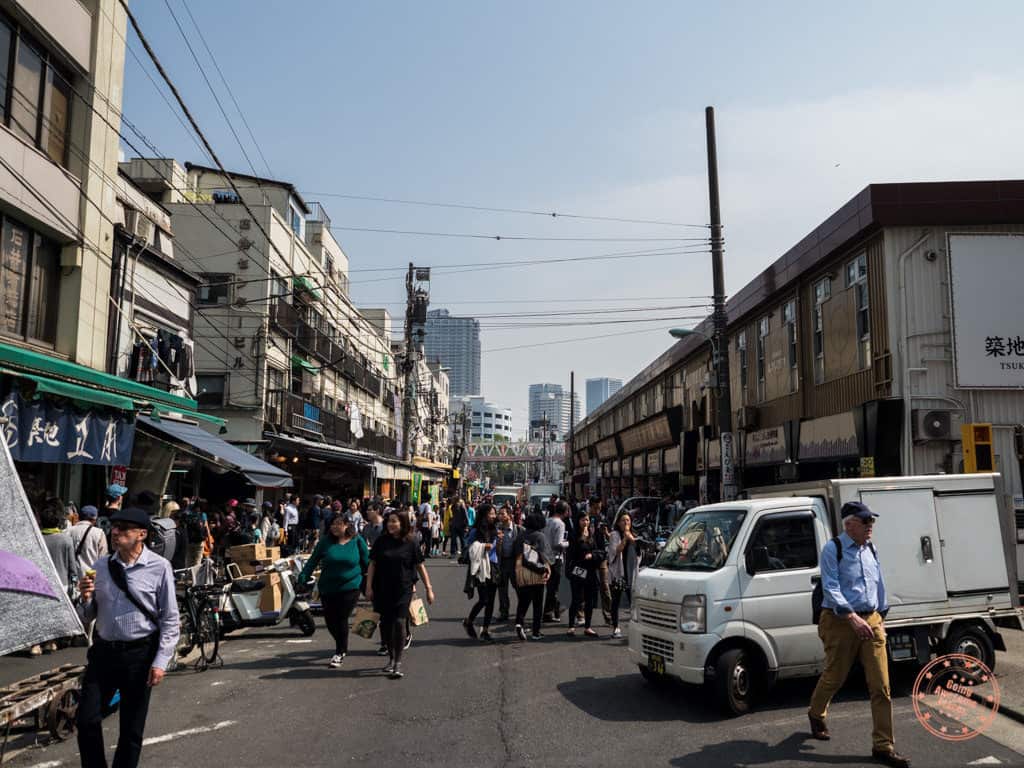
I’ll be straight with you. Planning a trip Japan always gives me a bit of an anxiety attack. I don’t know if it’s just me but this is coming from someone that’s been before too. Not to worry though, there are definitely ways to make that trip planning easier. Let me share with a few of my secrets.
What’s so tricky about Tokyo?
Essentially it boils down to the fact that there’s a mix of not having enough information and having too much information. How does that work you ask?
Well on the not enough front, there are is a lot of local content that is in Japanese-only which makes it challenge. Typically I try to seek out local content because you know it’s updated and fresh but you soon learn you’re out of luck.
There’s also too much information because everybody’s got their own take of where to go and it’s all so fragmented that you have to assemble it yourself. If we’re just talking about food, it’s probably worse because places we’re so used to relying on such as TripAdvisor and Yelp become pretty useless if you’re wanting non-touristy recommendations.
Language just plays a big part of why I feel like I have to work that much harder to figure out my trip plans. It could be as simple as trying to get from the subway to a connected building. From experience, I know it’s not as simple as you think because English signage will often be lacking or misleading.
Don’t even get me started on all the subway companies. Lines, I’d be totally okay with but when you have 48 operators in the world’s most extensive urban rail network, most of which don’t work with each other unless you have a special chip card, it’s bound to make your head spin.
I’ve gotten into so many brain cramping moments in Tokyo where I thought we could drop underground at a station only to realize that it’s a different company’s station.
Being prepared for Japan
Hopefully that doesn’t scare anyone off. Our second time around wasn’t without it’s own adventures and mishaps but knowing what to expect this time around and equipping myself with the right tech definitely saved us a number of times. Here are our top 5 tips.
- Get data – Life saver to be able to search things on the fly and use Google Maps to figure out which direction to walk once you pop out of the underground and to find all the restaurants we had marked. For those interested in pocket wifis, NinjaWifi is your best bet especially with the AWESOME15 code for 15% off. For a more global solution, we’ve also used Pokefi or Solis in the past., but these days eSIMs are just undeniably convenient. Airalo’s Japan eSIM is very reliable and we’ve also tested Ubigi which offers a 5G eSIM. Use code WILLIA9500 to get a $3 USD credit with Airalo or AWESOME10 to save 10% off your first order with Ubigi. Best part about Tokyo is that you don’t lose any signal in the subway.
- Plan on a Google sheet – I talk about this in the Art of Planning A Trip but I always have my entire itinerary ready for offline-use in case I ever need to refer back to it. This is where you’ll want to put in all your research especially directions and screenshots of things. If you need a little inspiration, make sure to read our full 12 day Japan itinerary.
- Tokyo subway map app – We ended up using Tokyo Metro Subway by Mapway Limited, when we didn’t have my paper map handy and needed a quick reference.
- Mark your places on the map ahead of time – Google Map’s custom maps is extremely handy (find out how you can get it too) where you can essentially mark every single restaurant and attraction you’re interested in. With data, you can access this map through the Google Map app, allowing you to navigate to them via GPS at any time. Alternatively, you can also just save points of interest on Google Maps and into a specific list. This is easier to access as you don’t have to go through the extra step of opening a custom map.
- Wear comfortable shoes – Have a step counter? You’re going to absolutely crush your targets. It goes without saying that there’s a TON of walking in Tokyo so make sure you bring comfy shoes. I like these boots and these shoes for the warmer weather.
Want to make money while doing all the insane walking you’re going to do? Download Sweatcoin where steps turn into goodies.
Japan Trip Planning Essentials and Discounts
If you’re in the middle of booking your trip to Japan, here are the most important places you need to go to book:
- JR Pass – The two most reliable places we always check are JRailPass and JRPass. If you are taking long distance Shinkansen across multiple region, get the full JR Pass. If you’re focusing on one specific area, you only need a JR regional pass.
- Shinkansen – The JR Pass prices have gone up and for many of you, it’ll make more sense to book tickets individually. The secret is that when you buy your Shinkansen tickets through Klook offers special vouchers for Don Quijote and BIC when booking. Their tickets are super easy to redeem as well. Right now, use code SKS10OFF to save $10 USD off.
- Hotels/Ryokans – In Japan, the best website for accommodations, hands down is Agoda. When we’ve compared them against Booking, Agoda consistently came out cheaper.
- Tours – While Viator and GetYourGuide are our go-to’s, Klook and KKDay are much popular in Asia so it’s always worth comparing across all of them to make sure you get the best price.
- Pocket Wifi – While we do love eSIMs, having a pocket wifi is great for sharing data with a large group. The most popular is NinjaWifi which is easy to pick up at the airport. Use code AWESOME15 to save 15% (automatically applied). Alternatives are offered by JRPass and JRailPass but they aren’t as cheap. For a more global solution, consider Solis and PokeFi.
- eSIM – The best one is Airalo. Save money by getting the Japan region eSIM and use referral code WILLIA9500 to get $3 USD credit on your first purchase. From now to Feb 29, the 10GB package is half price as well! Ubigi is another one that we’ve had success with where they uniquely offer 5G coverage. Use code AWESOME10 to save 10% on your first order.
- Car Rental – Big companies like Budget, Avis, and Enterprise operate in Japan but they’re usually the most expensive. The best companies are the local Japanese ones such as Toyota Rentacar, Nippon Rentacar, Orix Rentacar, Nissan Rentacar, and Times Car Rental. To make things easier, use Rentalcars and Klook to compare prices all in one place. Don’t forget, you need an IDP to drive in Japan so get one before you leave your home country.
- Learn Japanese – It helps to know even a bit of the language before you go. Start your learning with Rosetta Stone Japanese.
- Cash or credit – Cash is still very important to have in Japan but when you use credit cards, make sure you’re not getting charged those extra exchange rate fees. The best card right now is the Wise Multi-Currency Card which is actually a debit card where you can convert at favorable rates beforehand. This cuts out any sneaky transaction fees.
- Travel Insurance – Make sure you’re covered in case something happens. Get quotes from Insured Nomads and if you’re from Canada, get quotes from RATESDOTCA.
- Shopping – Discovering Don Quijote is a quintessential part of the Japan experience. The secret for tax-free shopping is that they have a coupon that can help you save 10% off + additional 5% off if you spend ¥10,000 or more.
Arriving and departing Tokyo
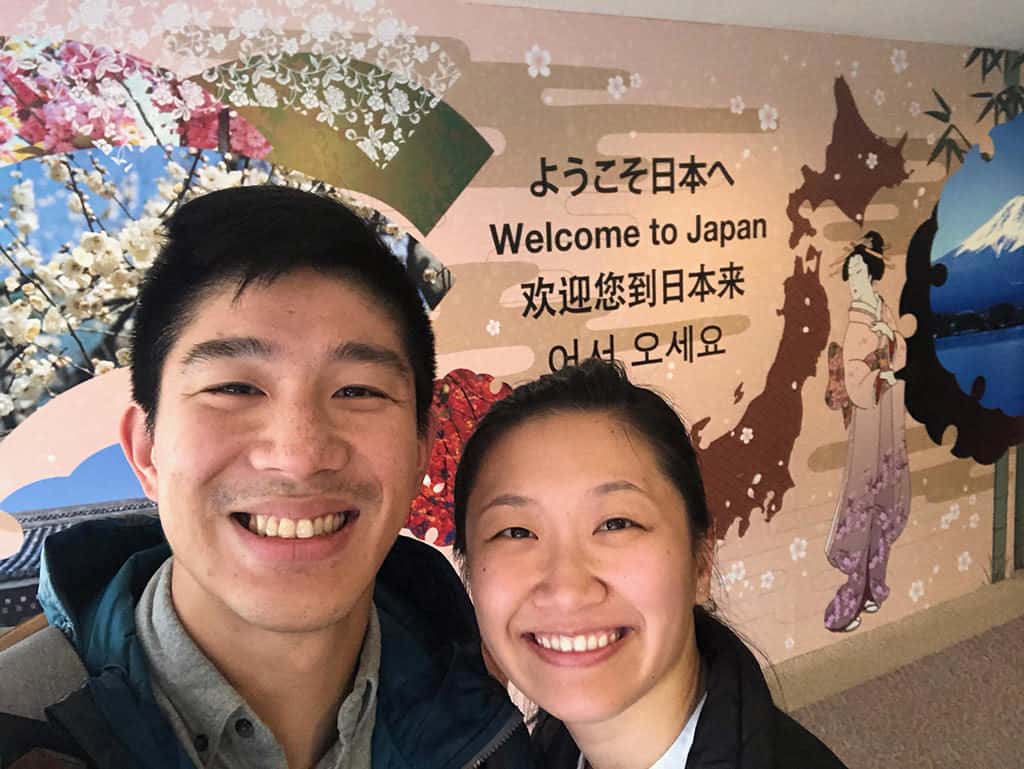
There are two main airports that service the city – Narita International Airport and Haneda Airport. Both cater to international arrivals and honestly if you had the choice, I would recommend flying into Haneda over Narita because it’s closer to the city and it has cheaper transit options compared to the alternative.
Narita
When you come out to the arrivals hall, you’re going to be overwhelmed with all the people waiting there and all the various stalls lining the wall. Your research ahead of time should help you figure out where you need to go as it really depends on where you’re going to in the city.
For some, the stalls right at the arrival hall floor will be what you’re looking for. Otherwise, you’re going to need to take the escalator down and that’s where you’ll find the huge JR storefront. This is also where you’ll find Keisei line.
We weren’t sure where to go at first so we asked the staff and they were very helpful in directing where we should go
For us, since we needed to be at Mizue Station, we caught a Keisei Main Line (Limited Express) train where we would eventually get off at Yawata. This cost 1,720 JPY.
Alternative options:
- Narita Express a.k.a. N’EX – 4,000 JPY but free with JR Pass
- Keisei’s Skyliner to Nippori and Ueno – 2,470 JPY
- Tokyo Shuttle bus to Tokyo Station – 1,000 JPY
- Taxi – Just don’t do it
Haneda
Like I said, Haneda is a convenient airport to fly into because it’s that much closer to the city and even closer if you’re staying in Yokohama.
The easiest way to get in and out of the airport is through either the Monorail for 490 JPY or the Keikyu Line 580 JPY to Tokyo Station.
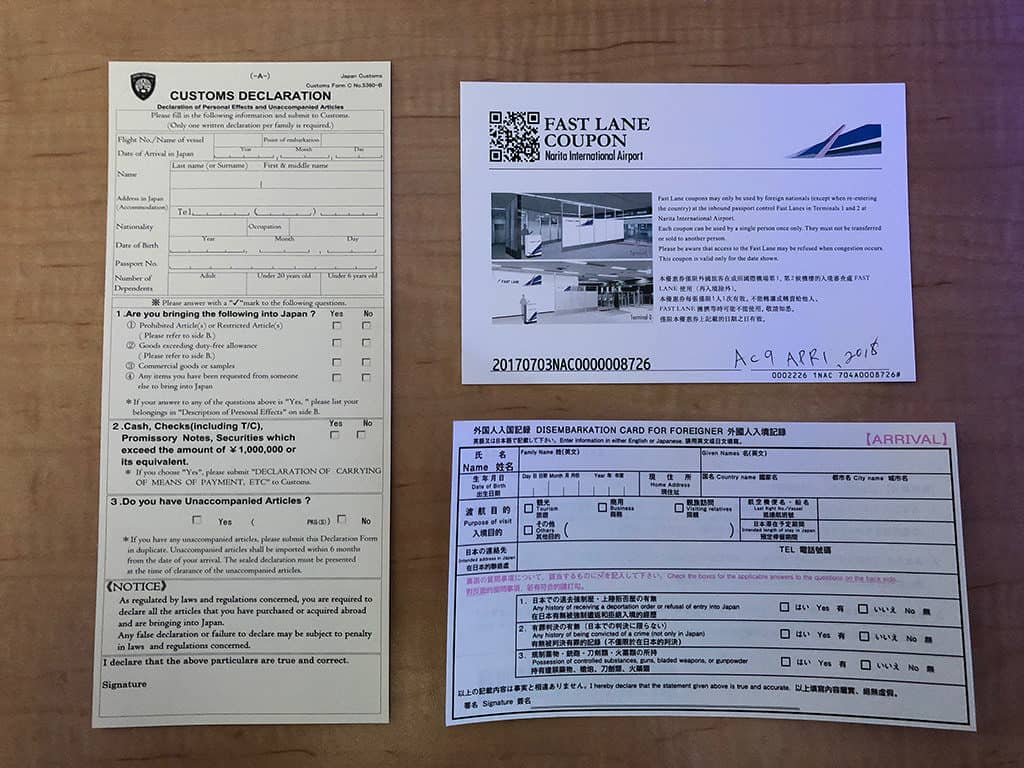
Did you know? Both airports have free wifi which is handy.
Keep in mind – Officially, there are accessibility options in the underground but they aren’t the friendliest in convenience. We brought only carry-on luggage with us but there were a ton of times we had to carry them up steps.
Where to stay in Tokyo?
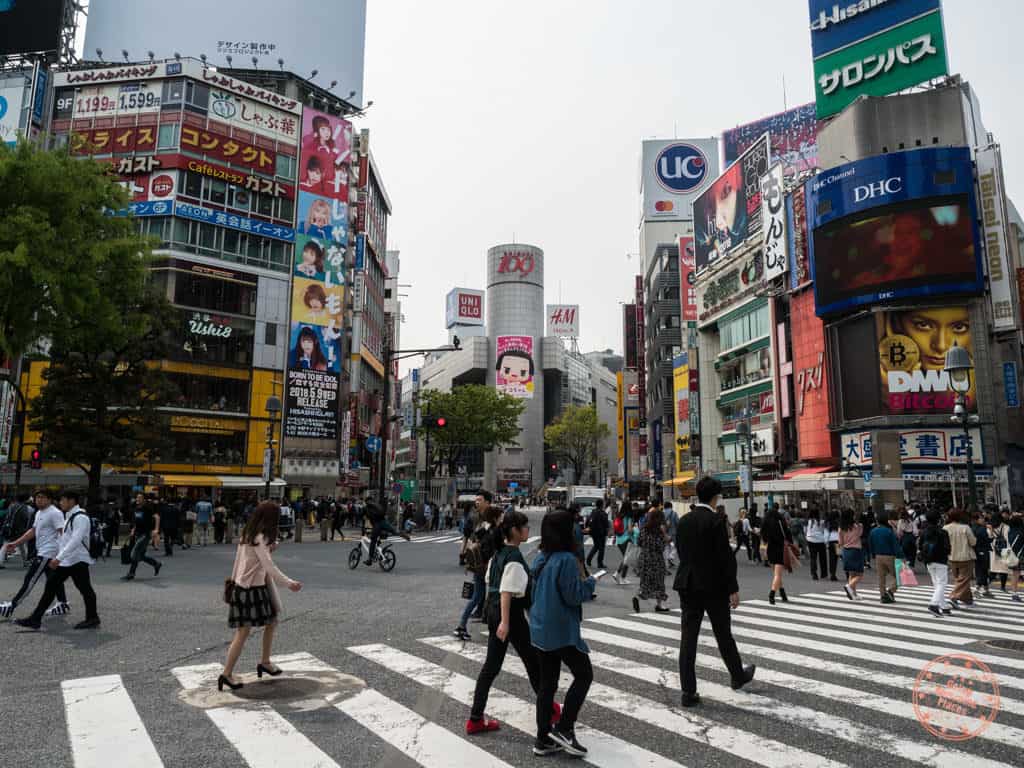
Talk about some serious contrast. Between our two trips to Tokyo, one was an ultra luxurious stay on points and the most recent one, an Airbnb at the fringes of the city.
There is a lot of choice of accommodations in Tokyo but to help you make your decision, the few things that you want to think about are:
- What is your budget?
- What neighbourhood do you want to be in?
- Do you want to do a pod hotel?
- How close do you want to be to a subway station (the answer is “very close”)
Recently I put together a “where to stay in Tokyo” guide which will help you figure out what neighbourhoods you want to be in for your upcoming trip to Japan.
Where to stay in Tokyo
Where did we stay?
Like I said, truly a tale of two properties. The below are two of the places we’ve personally stayed at. Let me go into why you should one of those would be a good choice for you and if those don’t float your boat, I have a solid recommendation you can think about.
Remember, for additional savings, my Booking.com offer to get $25 CAD back is still on.
LUXURY
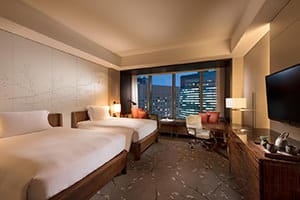
This property is well deserved of Hilton’s top brand. Located near Shimbashi and Shiodome, this is located in a financial area which means there isn’t too much around directly in its vicinity but Shimbashi certainly makes up for it. We stayed here on points back in 2012 and were very impressed with the room, executive lounge, the lobby, and impeccable service.
BUDGET
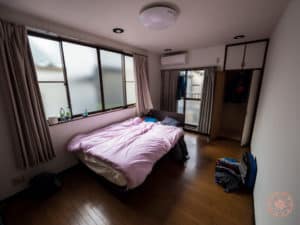
Since we booked our most recent trip to Tokyo very last minute and during the Cherry Blossom season, we elected to stay somewhere a little further away from the city to save money. Browsing through Airbnb’s supply, we encountered this particular room at $22 CAD a night. While cheap, this was definitely a no-frills kind of place (we even had to bring our own pillows). Bathrooms were communal as well in this 5 room house so in a lot of ways it was like a hostel. The walk to the Mizue station on the Toei line was roughly 13 minutes and another 30 minutes into the city. Can’t beat the price though.
If I were to do it again, I’d probably recommend a place like this.
CONSIDER THIS

HOTEL SUNROUTE HIGASHI SHINJUKU
Located near Shinjuku, this hotel is conveniently located 10 minutes walk from the Isetan department store and more importantly right by the train station. The rooms are spacious, clean, and comfortable and up to standards as a mid-level hotel.
Neighbourhoods you want to be near
So as you can see, two drastically different accommodation experiences in Tokyo.
Having done both, I can confidently say that, staying in the city is much better. I say that because of convenience. When staying in the suburbs of Tokyo, we wasted a good 2 hours each day just commuting back and forth. Another thing you want to take into consideration when picking a neighbourhood is whether you want to go to the Toyosu Fish Market. It’s in an awkward part of the city and to make the 5:30AM meeting, you will either have to take a cab or stay right by Toyosu. I have a full new guide on the Toyosu Fish Market tuna auction experience.
Here are a few neighbourhoods that you want to consider being close to especially with their high concentration of things to do and restaurants.
- Shibuya – Famous for the crossing but also awesome for shopping, restaurants, and bars
- Shinjuku – A place that is super lively at night. This is where you’ll find Piss Alley but also the amazing Shin Udon.
- Akihabara – Nerd central here and a must-do for anyone that loves anime and electronics. Conveniently located and with tons shopping and restaurants nearby.
- Tokyo Station/Ginza – One of the more expensive areas to stay but if you can swing it, you’re right in the heart of some of the best food, shopping, and attractions like the Imperial Palace.
- Harajuku/Omotesando – One of my favourite areas as it’s a clash of the fancy shops along the main strip of Omotesando and then you have the quirky and grungy Harajuku. Meiji Shrine is also right there.
- Asakusa – Asakusa is one of the most popular destinations among tourists coming to Tokyo for the famous Kaminarimon gate and Sensoji temple. However, if you want to learn something about Asakusa or Japanese culture and explore less “touristy” places, it’ll be better if you have a local guide. This Asakusa Cultural & Street-food Walking Tour is offered by Magical Trip and you’ll have a informative and friendly guide who will give you a lot of new knowledge. For lunch you’ll cook Okonomiyaki or Monjayaki for yourself with an instruction from your guide and taste it!
- Ikebekuro – We didn’t get to visit here but I know this is a popular place for many restaurants.
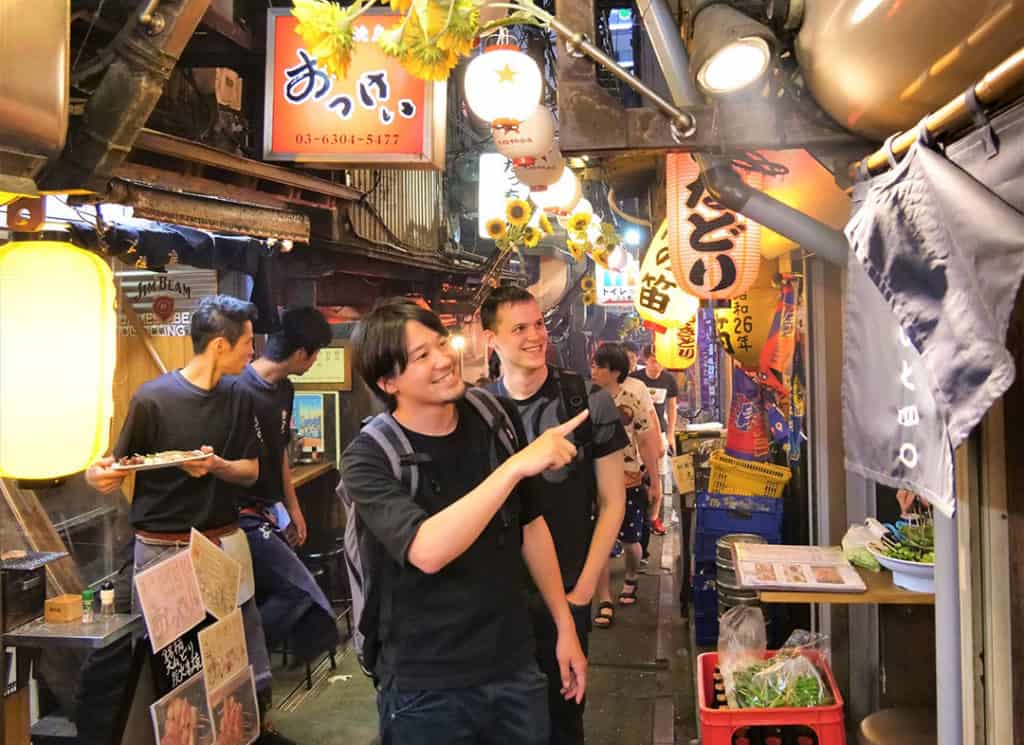
Tip: If you want to enjoy the nightlife, especially local drinking and dining culture in Shibuya and Shinjuku with awesome local people, Tokyo Bar Hopping Food Tours by MagicalTrip is your best choice
Did you know? Coming from North America? Good news! You don’t need any outlet adapters. It’s the same plug and almost all electronics you have now have no issues with Japan’s 100V vs 120V.
Getting around Tokyo
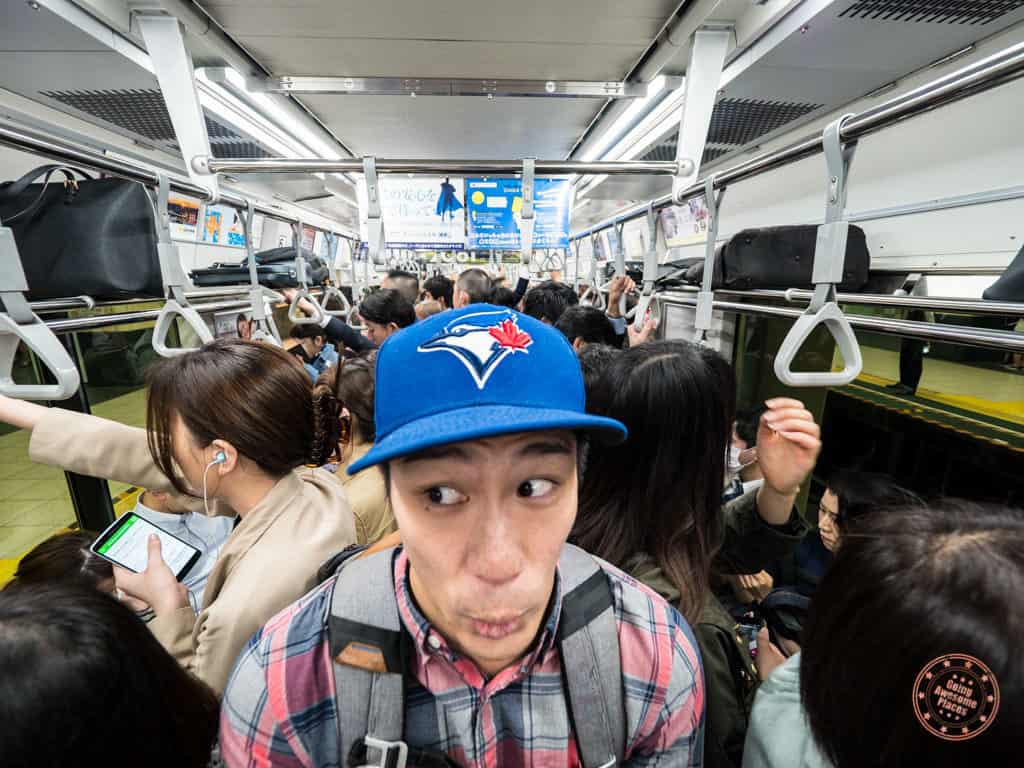
Alright one more thing before we get into the meat of what you care about. This is a super important topic in my opinion because this is what’s going to give you the most headache.
As I mentioned, there are a lot of options when you’re in Tokyo and that’s a great thing because it can take you anywhere you want to go. What’s not-so-great is the fact that there are so many companies. It almost feels like you need to be choose sides when you’re in the city. Do you align yourself with Tokyo Subway? Toei? JR? Keikyu? Tokyu? Odakyu? Keio?…you get the idea.
Which is the best line?
If you’re looking for the most comprehensive lines, Tokyo Metro is going to be your best bet. They also work closely with Toei which creates a very wide network.
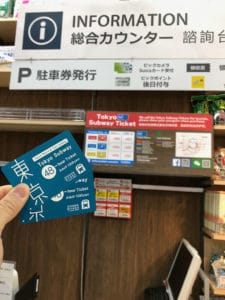
What pass should you get? Luckily, there’s are very affordable Tokyo Metro + Toei day pass options which in my opinion offers the best value.
- 24 hours – 800 JPY
- 48 hours – 1,200 JPY
- 72 hours – 1,500 JPY
These passes are great if you think you can make it work with one line and you know you’re going to be taking it quite a bit.
The tricky thing you have to consider though is where to buy it. When you land in Narita or Haneda, you should buy it right away and that’s a no-brainer but if you’re trying to buy one in the middle of your trip, it’ll be a bit more work. You can either buy them at designated Tokyo Metro Pass Offices in specific stations or you can try to find a nearby BIC Camera or LAOX electronic stores. There were several times where we weren’t able to link up one pass with another because 1) they don’t allow you to buy multiple passes and 2) we lived by a station that didn’t sell these passes.
When buying the pass, make sure you have a passport with you. For all the locations where you can buy the pass head here.
What about the JR line?
Love the JR line but unless you somehow have excess hours from your JR Pass, I don’t think it’s worth it to get special day passes with them.
That being said, the JR Line can come in handy for some routes especially with their Yamanote and Chuo Lines. That’s where the IC cards come in handy.
Be company agnostic with IC Cards
For years I relied on the special day passes but what you should be looking for is an IC (tappable) card once you land. The main reason is because these cards work on any and all systems. All you have to do load money into it and you tap-and-go. There is also a small discount offered on the fare to promote the use of these cards.
The one I’d recommend getting is PASMO which you can buy from a machine without having to go to a special location.
The deposit for a PASMO card is 500 JPY. All you have to do is load money onto the card and then that allows you to tap the card when you take any line in Tokyo. There’s a small discount for using the card and you won’t be restricted to any specific company.
A competitor to PASMO is Suica but they are essentially the same thing especially in Tokyo. Japan Rail Pass explains the difference very well in its FAQ.
Tip: If you want to be super organized and have everything ready before you arrive, you can get a Suica card online and pick it up at the airport, or even have it shipped internationally, although it might cost a bit more.
What gotcha’s should you look out for
From personal experience, I have two examples of when I was a little frustrated with the subway.
- We wanted to get from Shibuya to Ebisu. Look on the map and you’ll see that there’s no direct way to do that with Tokyo Metro. While it would’ve been one stop with JR’s Yamanote Line, we were committed to Tokyo Metro with their 48 hour pass. We looked at the transfers we’d need to do and decided that walking it was a better choice instead. That said, you could totally take the Tokyo Metro where you can refer to their subway map to find out the best way to get from stop to stop.
- We were in Asakusa and we were looking for a way to get home. We followed signs to the Asakusa station but when we went underground, we realized the station was run by a company called “Tsukuba”. This is when we realized we went the wrong direction completely. In frustration, we double backed to head to the Tokyo Metro and Toei’s Asakusa station.
Lesson learned: Look more closely at the map and go with a PASMO card next time so you’re not locked into a specific train company like we were.
Food in Tokyo
Are you read to eat?? You better be!
FINALLY, we got all of the boring stuff out of the way. Don’t worry, it was part of the strategy. Just like waiting in line for food, my theory is that the food always tastes 10x better because you’re so hungry at that point.
The one thing that you notice immediately with food in Japan is how meticulously prepared and presented everything is. It’s not just the beautifully displayed plastic models of food but it’s also the the careful selection of Japanese ingredients that are paired together, and the freshness of what’s used to really bring out the flavours.
Whether you do a Tokyo Night Foodie Tour in Shinjuku or go out on your own, there are so many things you have to know about food in Tokyo but let’s start with the basics.
General things you need to know for feasting in Tokyo:
Best value for meals: As Mark Weins recommends, lunch menus are indeed that much cheaper than dinner. Now this doesn’t apply across the board as there are a number of places that are only opening for dinner. From my experience, this only applied to fancier restaurants like Tempura Shinjuku that we visited. If you plan on doing omakase, lunch is always cheaper than dinner if offered. As Mark did, we often had 2-3 lunches a day and did something much more casual for dinner.
Places don’t open that early: One thing you learn pretty quickly is that most restaurants don’t open until 11AM so as much as you’d like to start your eating earlier so you can spread things out across the morning and afternoon, it’s quite hard to do because of the starting hour. The only exception is of course Toyusu Fish Market. As a result, use the mornings to either make sure you’re first in line at a place, do Toyosu, or sleep in.
Tipping: I love that tipping is not part of Japanese culture. What you see is what you pay and nothing more. There’s no expectation to tip and some will in fact reject it even if you try.
Cash vs. Card: How card friendly is Japan? It’s actually quite easy to use credit card throughout the country. I was half expecting American Express to be rejected in many places but I almost used my awesome point earning cards with ease. That being said, it’s good to have cash on hand because there will be lots of places that won’t accept it or it just wouldn’t be convenient to. Street food, Tsukiji outer market vendors, and Piss Alley are good examples.
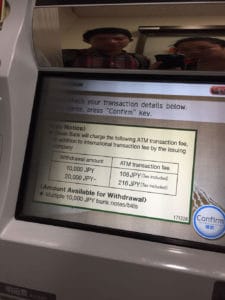
Withdrawing from ATM: During our two trips to Japan, we never found an ATM that didn’t have any fees. In fact, most of the “official-looking” would reject our Canadian debit card. The one place which would take our card was the ATM inside the 7-Eleven. The fees are unavoidable and at the time of writing, it cost 216 JPY for withdrawals > 20,000 JPY and 108 JPY for a 10,000 JPY withdrawal. The machines also only dish out denominations of 10,000 JPY.
Tax: One thing I’ve gotten used to in Asia is not having to deal with tax but Japan does have tax (sometimes) and the current rate is 8%. What wasn’t clear though is that there were definitely places that didn’t seem to charge tax but those tended to be the more local cash places and it’s possible tax was included in the price.
Depachika: These are the basement floors of big department stores. If you din’t know, you might hesitate to go to a fancy looking luxury mega-plex but then you’d be missing out on all the amazing food. From hot foods to desserts, Depachika’s are a feast for the eyes. Most of the times you won’t know the items are but this is a great place to randomly try things. Ginza is a prime example of this where high-fashion Matsuya, Ginza Six, and Mitsukoshi are hiding a vault of deliciousness.
Finding restaurants: Honestly, without data, we would’ve had 10x more trouble finding some of these restaurants. What you’ll find is that many restaurant names are only in Japanese characters. While it may have a translated English phonetic name, you’ll see no such name at the storefront. There were many times where we had to search for images of restaurant to see what the entrance looked like. If you don’t have data, I highly recommend you taking screenshots of the restaurant before heading out. Another thing to keep in mind is that there are a lot of restaurants hidden in multi-story buildings so you have to look for their name on the sign outside to figure out what floor they’re on.
Etiquette: We learned this from our time with Arigato Japan Food Tours, here are 3 taboos for chopsticks that are worth knowing:
- Don’t pass food to another person from chopstick to chopstick
- Don’t stick your chopsticks vertically in your bowl of rice
- Don’t pull your plate or bowl with your chopsticks
Eating on a budget: Tokyo isn’t a cheap place to travel nor is the food friendly for those on a serious budget but there are a few ways to do it if you’re looking to save money in between the splurging you might do :D
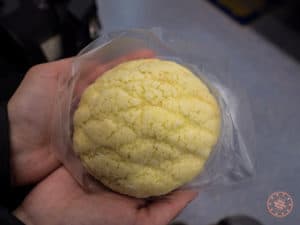
- 7-Eleven and other convenient stores – Like what we experienced in Taiwan, there is a ton of awesome food to pick up here. My favourite are the rice triangles called Onigiri especially with tuna or salmon. Anything you find here is usually pretty cheap.
- Bento boxes in Depachika – While food in depachika’s aren’t always cheap, there are great gems here. Seek out the bento boxes as they’re pretty tasty without being overpriced.
- Bakeries – Similar to Chinese bakeries, buns, breads, cakes, and pastries of all sorts can be found here. These typically make great breakfasts or if you need a quick meal on say a train ride.
- Fast food – You’ll see chains such as Yoshinoya and Sukiya all around the city. While we tried our best to avoid these, they’re good for a quick cheap bite in a pinch.
- Vending machine restaurants – On our food walking tour, we passed by a number of ramen shops frequented by salarymen (what they call the homogenous men in suits) that had vending machines where you’d pay for your noodles up front and be served in minutes. They’re not going to be the best quality but I’m sure they could beat many restaurants back home any day and still be affordable.
You can’t really share food: Originally we thought we could try to share dishes in an attempt to try more restaurants during lunch but we learned quickly that this strategy doesn’t really work in Japan because of the limited space. Some have explicit rules and others you just didn’t want to be THAT tourist.
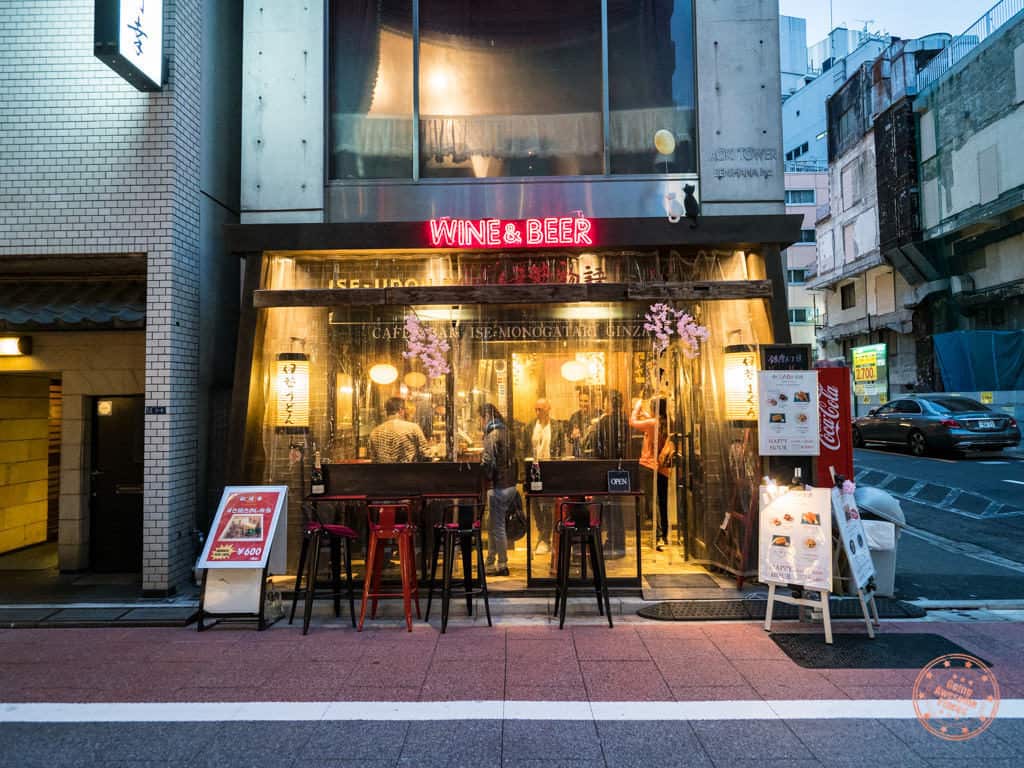
Think about doing a food tour: As much as you’re going to want to eat often and always, the size of your stomach and metabolism are going to smack you in the face. An awesome discovery we made was how good the food tours run by Arigato Japan Food Tours are. Instead of being limited to a dish per person when going out for dinner, sample an assortment foods in one night across a number of hidden gem restaurants in the company of a super knowledgable guide and fellow travellers. The particular tour we did covered Yurakucho, Ginza, and Shimbashi and is called their Allstar tour.
Wait so what happened to Tsukiji Fish Market?: That’s a great question. As of October 11, 2018, Tsukiji’s inner market shut down and everything shifted over to the brand new massive grounds of Toyosu Market. The good news is that Tsukiji’s outer market is still fully intact so I think it’s still worth going there because there’s a lot of food to try there and a ton of vendors that stayed. The bad news is that all the top restaurants (Daiwa, Sushi Dai, Nakaya etc.) and the tuna auction have moved to Toyosu which is further away and slightly more inconvenient to get to. I’m not going to go through how Toyosu Market works but I visited again in 2019 and I share everything I learned including the lottery system.
Explore Tsukiji with Magical Trip. On this Tsukiji Fish Market Tour by Magical Trip, you’ll walk around the famous Tsukiji fish market with a local guide, getting some new insights into the Tsukiji area and Japanese culture. You will also visit the Japanese Buddhism Temple and Shinto Shrine to find what our religious culture is like. And, most importantly, you will have a gorgeous seafood DONBURI (bowl) for lunch.
9 Best Restaurants You Have To Try
My mindset of these restaurant selections was that I was looking for places that weren’t going to blow up the bank, didn’t require reservation, but were highly recommended and ranked by other influential food blogs. I also took the advice of a number of friends that I consider to be foodie experts in Japan. What I didn’t use was anything like TripAdvisor or Yelp.
Let me be clear though, we were in the city for 6 days, and really less if you factor in our time in Tochigi, so we were quite aggressive in working out our stomachs and our feet. You can do it too but carefully plan out how you’re going to break down your days and your spread of Japanese food you’re going to try. What I mean is, if you already have a good tempura place in the plans, that means that you should probably cut out any other good tempura restaurant you also have in your list. If only you could do it all right?…or could you?
Here are my picks for top restaurants you’re going to want to add to your Tokyo itinerary whether you only have 1 day or 2 weeks. They range from small stalls, dessert shops, and fancier establishments. They are in no particular order but the ones near the top are the ones I have a little more attachment to but honestly all are worth going to. Here we go!
1. Uoriki Kaisen Sushi (海鮮 魚力 渋谷東急東横店)
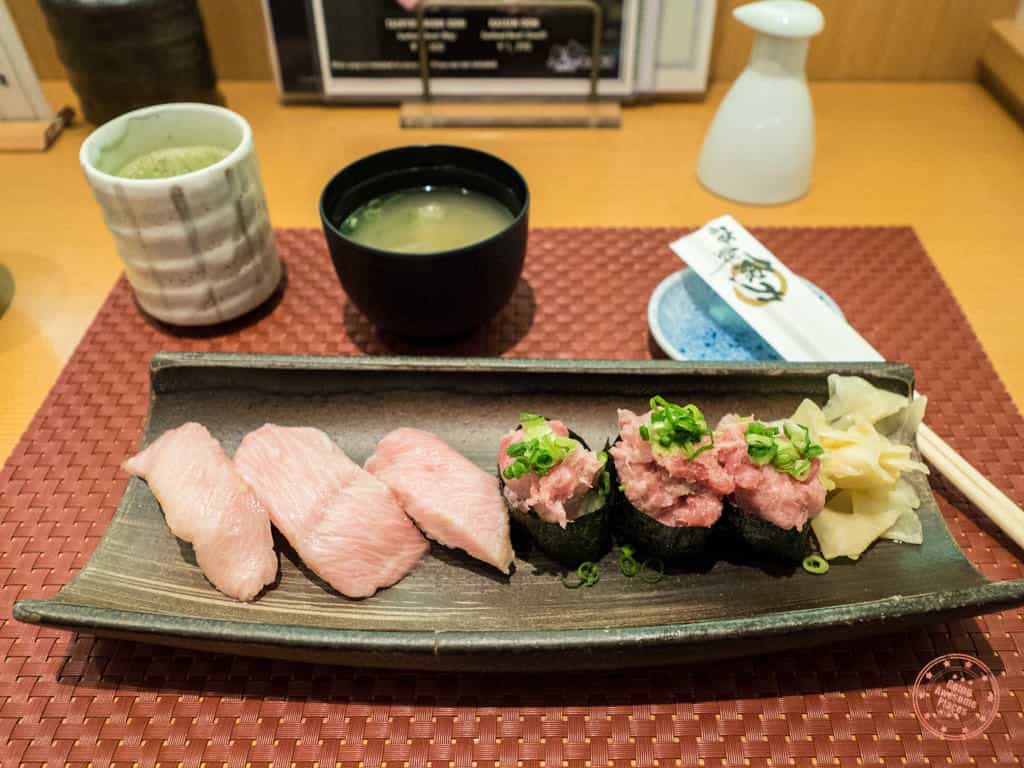
Tucked away and hidden next to a giant supermarket is this nondescript sushi restaurant that we never would’ve gone to if it wasn’t recommended to us. You could tell that it was super local too when we wrote our name down on the piece of paper and sat beside two grandmas that were also waiting for a spot.
The sushi here was fabulous especially the fatty tuna which was seriously melt-in-your-mouth good. Out of all the toro that we had in Tokyo, Uoriki was definitely the most memorable and most fatty. For the tuna set, I preferred the nigiri because you could really taste the textures and flavours of the fish while Chantelle liked the maki more because of the combination of diced tuna with scallion.
The seasonal sushi set we had was GOOD but the uni that day disappointed a little as it didn’t have quite the creamy texture we were expecting.
When ordering they asked us if we wanted wasabi but what they really meant was whether we were okay to have wasabi in our sushi which we did. All you have to do is dip in soy sauce and enjoy.
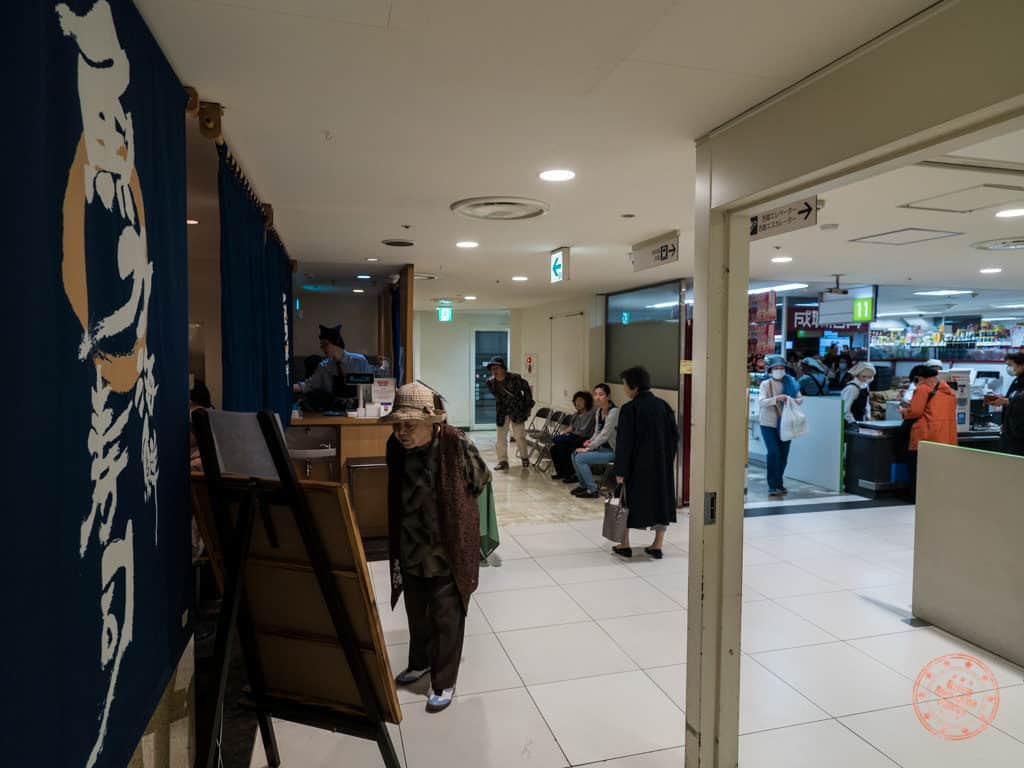

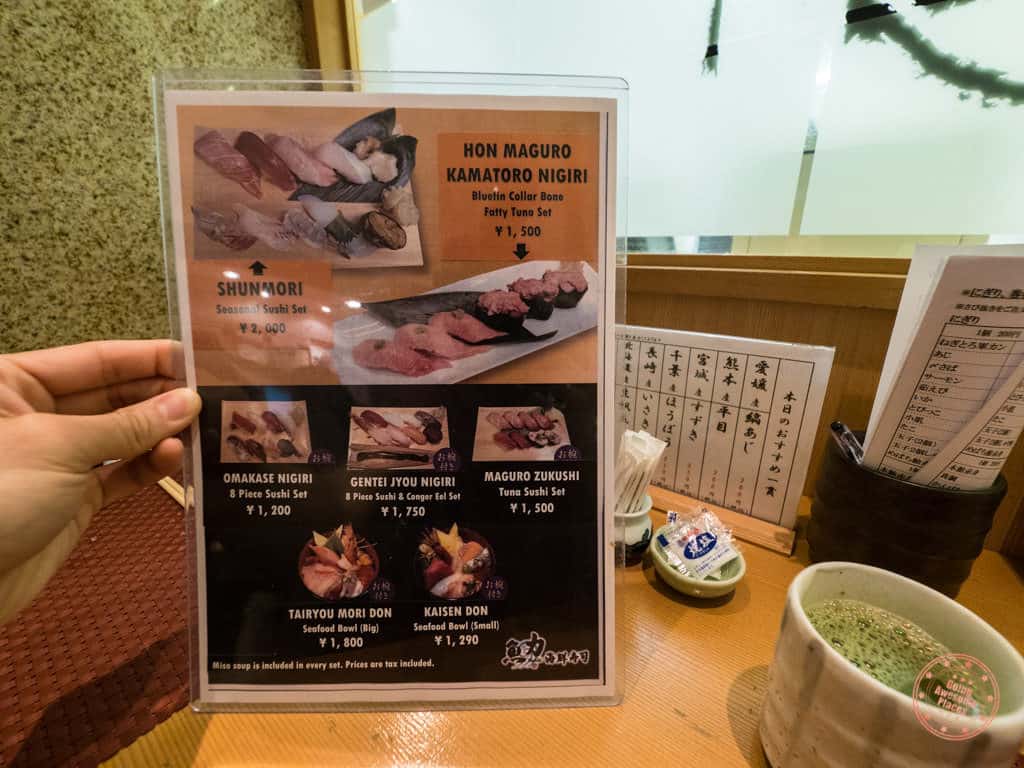
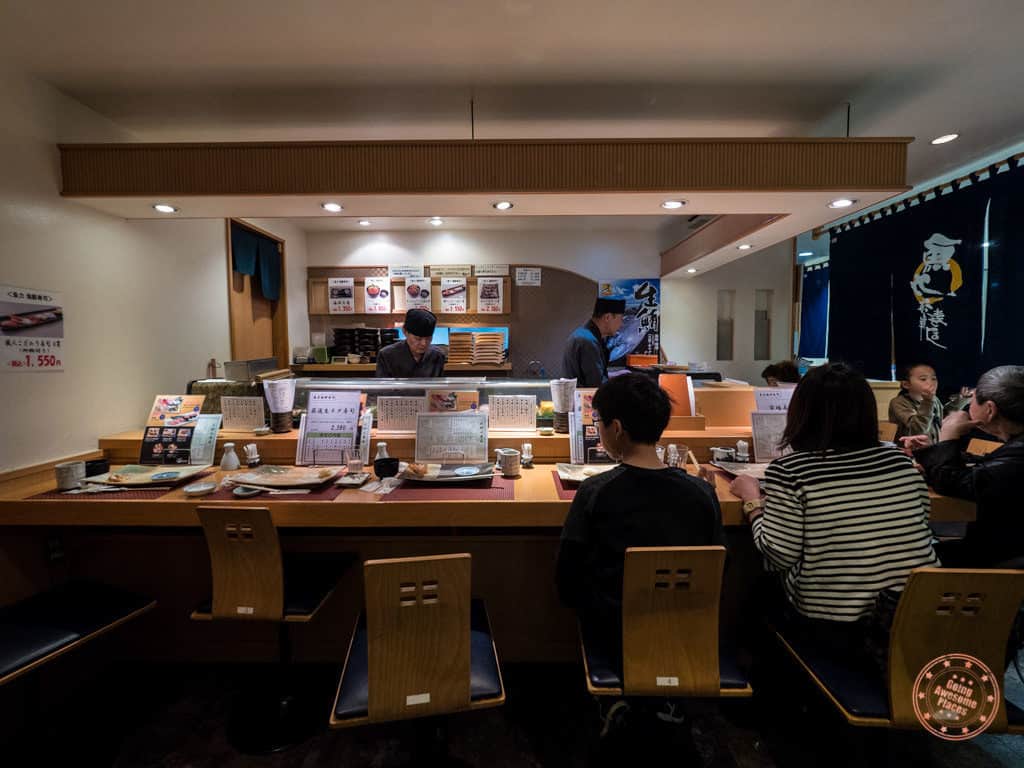
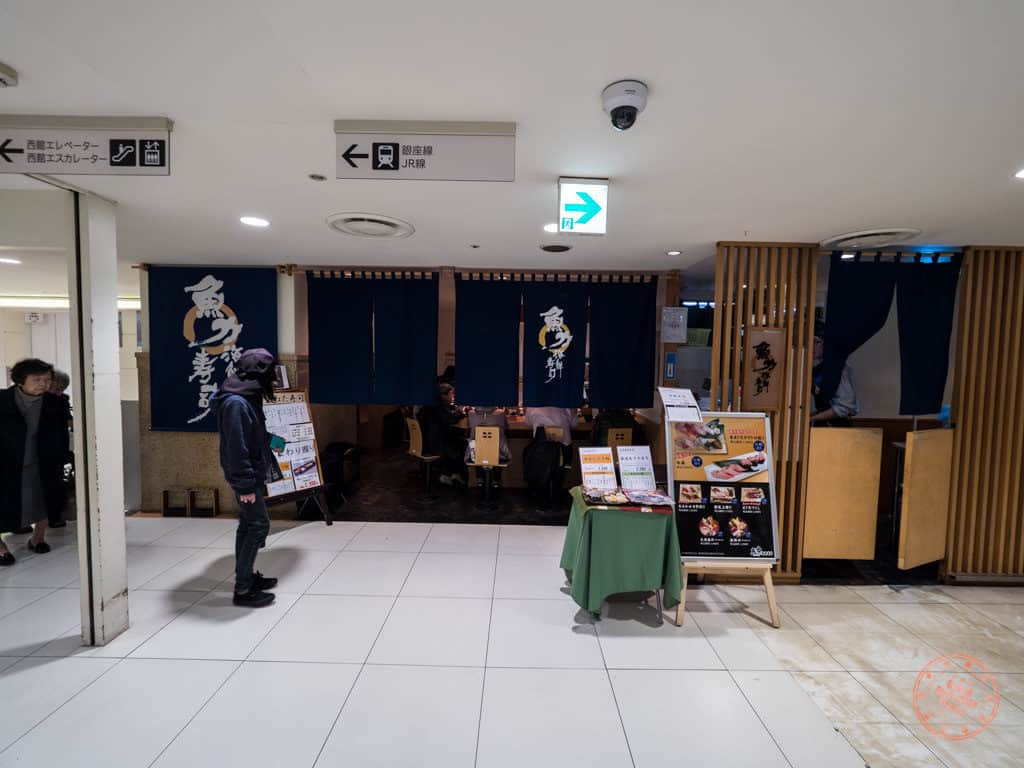
Neighbourhood: Shibuya
Open hours: 10AM – 9PM M-Su
Address: Basement floor (B1) of the Tokyu Department Store at Shibuya station (see map)
Price: Fatty tuna set (1,500 JPY – $14 USD), Seasonal sushi set (2,000 JPY – $19 USD)
English menu?: Yes
2. Shin Udon (慎)
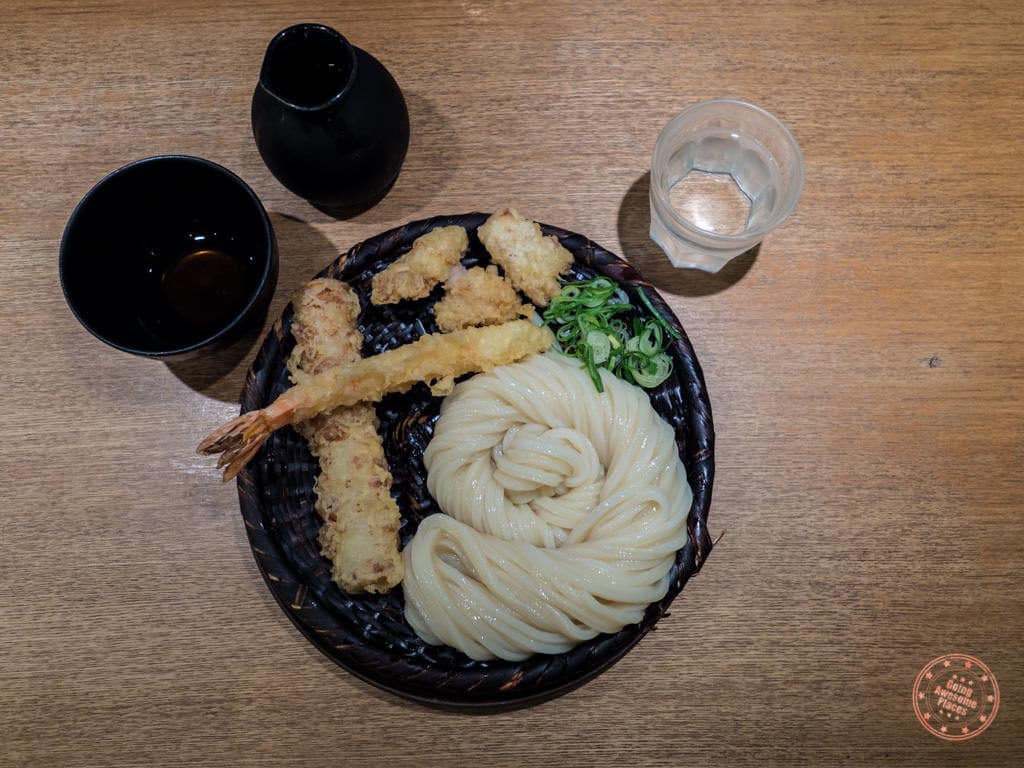
Ramen gets all the hype these days but what about its friendly, slightly chubbier cousin udon? Well friends, not to worry because udon is making a comeback here at one of the few restaurants we actually waited in line for.
We didn’t know what to expect when our friend jotted this place down in a Whatsapp message a few days before leaving but the timing of our hunger worked out when we ended up in Shinjuku. Arriving just past 7:30PM, we had to navigate a quiet dark alley before turning into another alley, but this time with a crazy line of tourists.
When we finally got inside, we could see why it took so long. With a maximum of 12 seats, it’s tight quarters inside which is pretty common in Tokyo. True to Japanese efficiency, we put in our order while we were in line so it only took 10 minutes for us to receive our udon.
I ordered the soy sauce udon noodles with yuzu pepper jelly, grated daikon radish, and chikuwa (bamboo shaped fish cake). Chantelle ordered the cold bamboo tray of noodles with shrimp tempura, chikuwa, and kashiwa (chicken) tempura.
Verdict? This is hands down the most amazing udon we’ve ever had. Thanks for our line mates who were Tokyo locals, they said the best way to truly appreciate the handmade udon is with a cold udon dish and boy were we glad we did. The al dente noodles had the perfect amount of bounce that you never get from the frozen udon we buy at home. The flavour combination was also excellently done especially with how the yuzu was used to delicately balance the grated radish. I normally don’t like radish but when you put it all together, it’s some kind of amazing.
Chantelle’s tempura was also perfectly battered – crispy on the outside while tender inside. While they looked somewhat similar, hers came with a soba-like sauce.

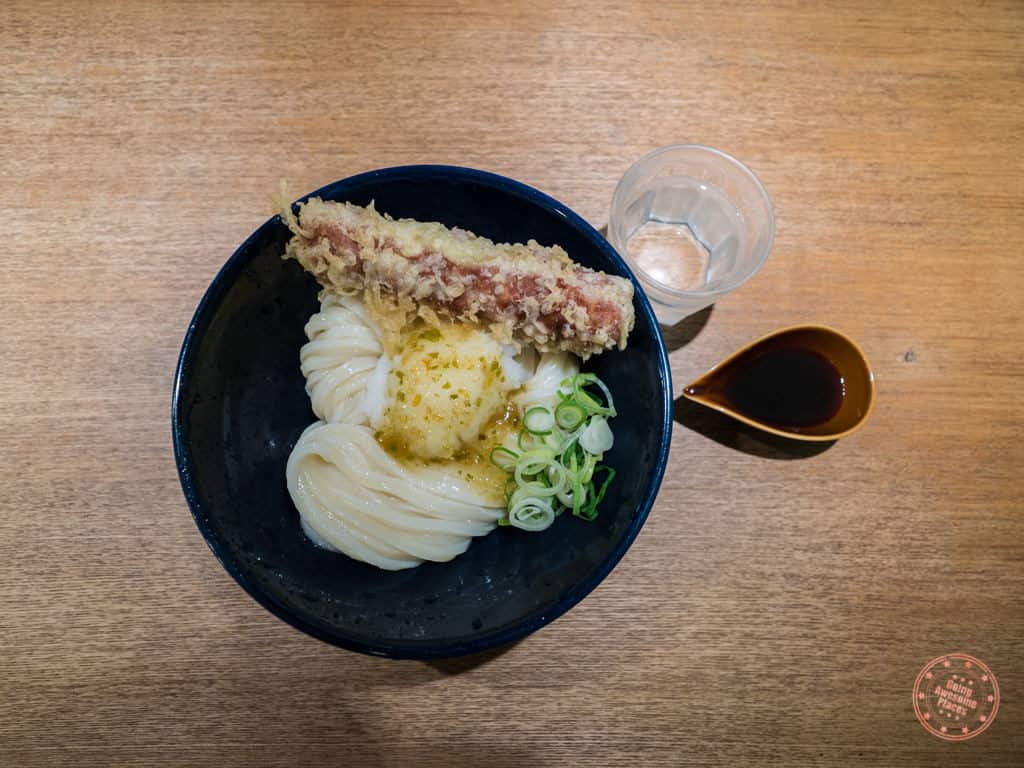
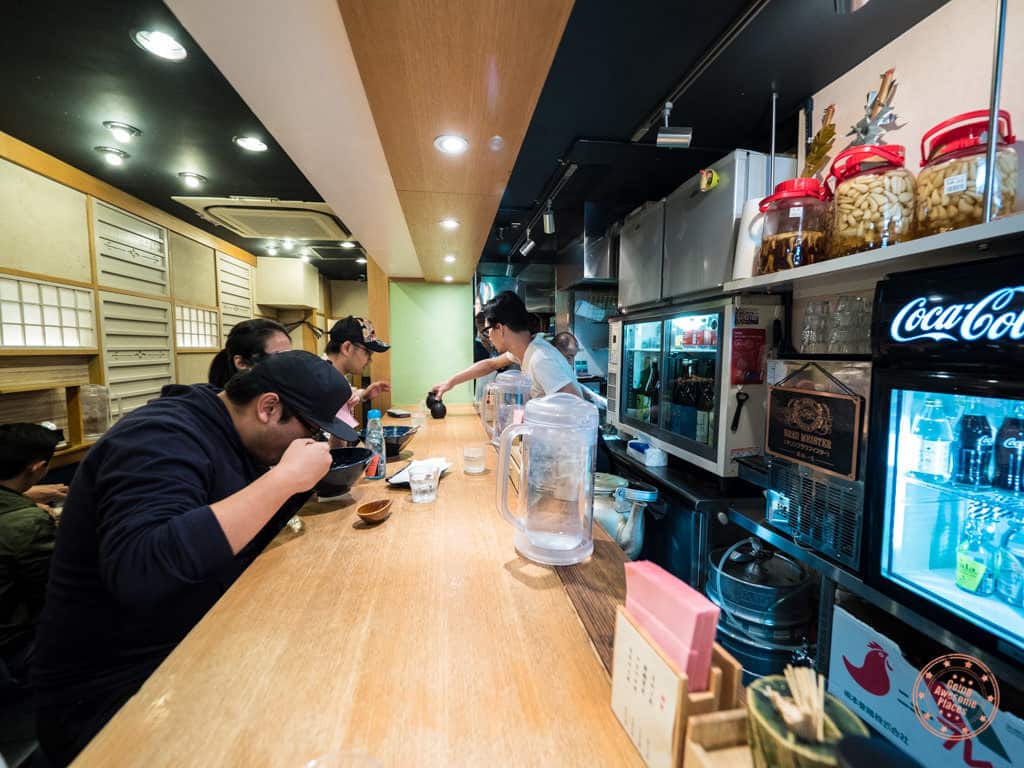
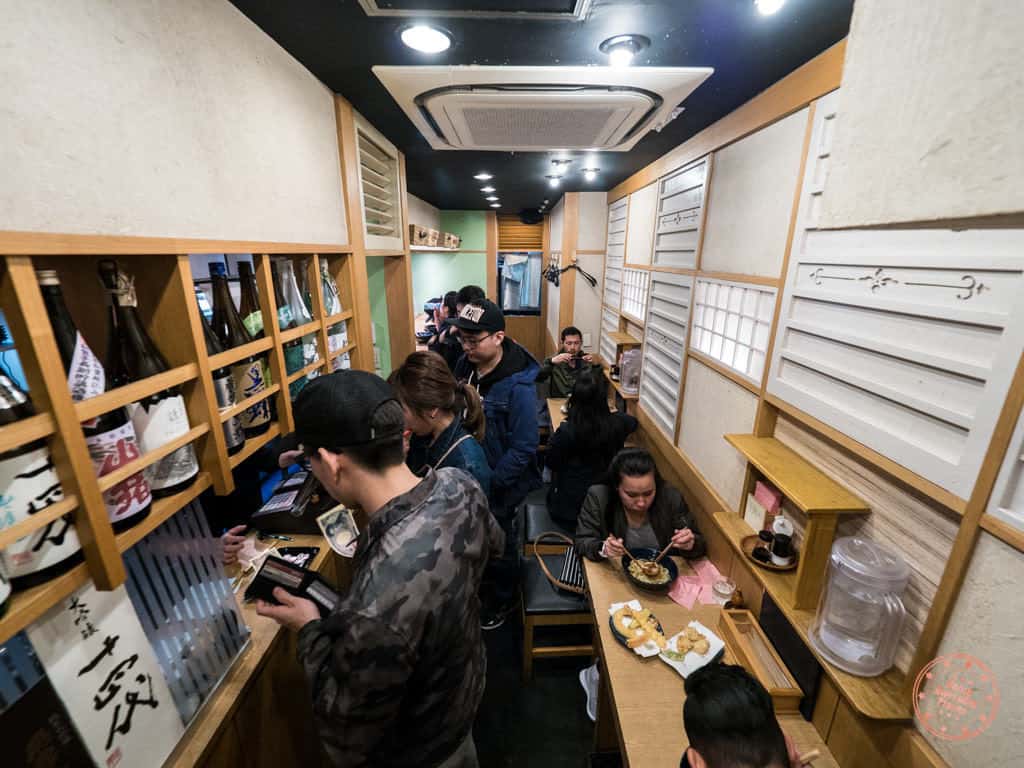
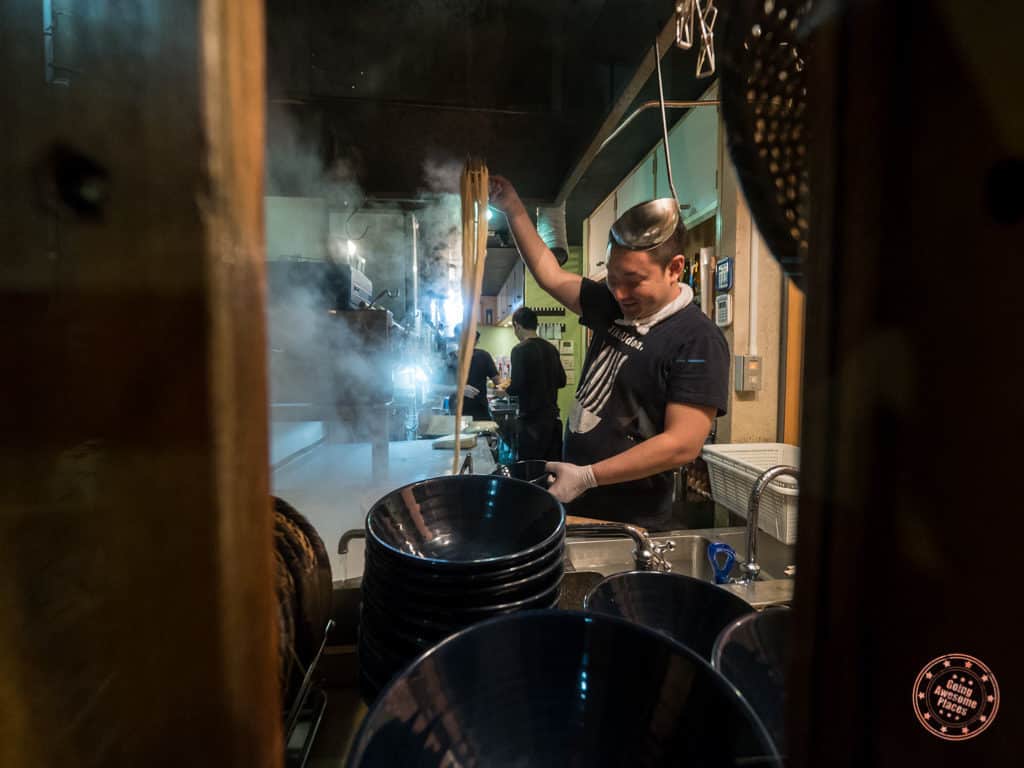
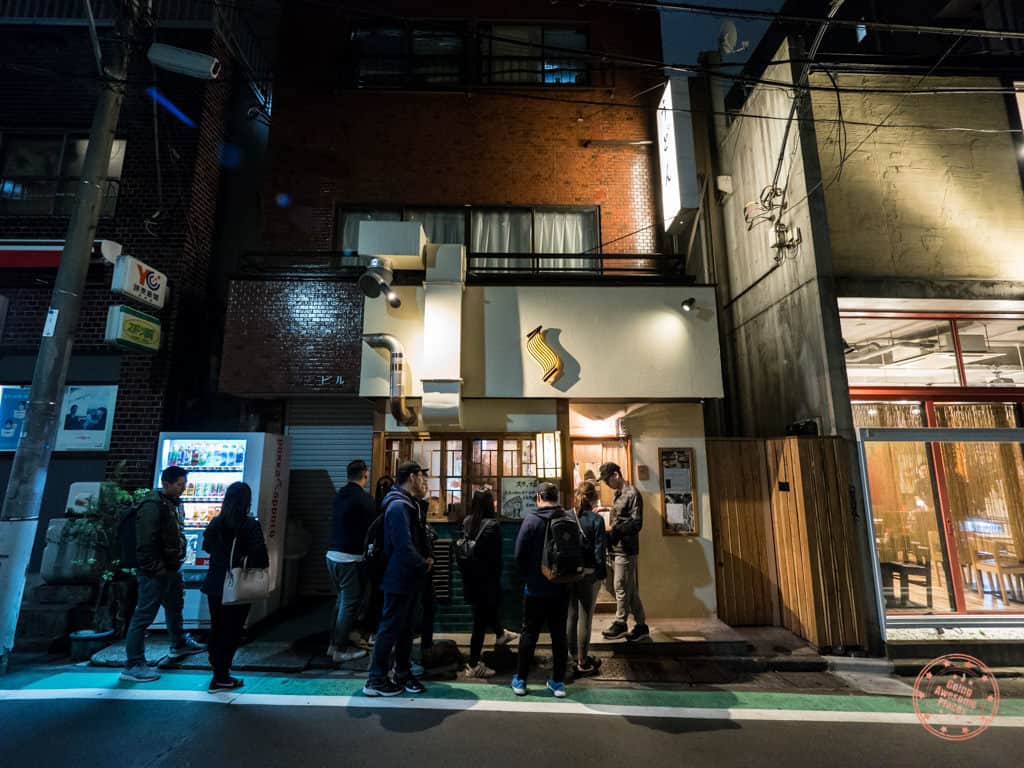
Water is included at no cost. We sat at the bar table and there was a big jug in front of us.
Other recommended items: There’s a cold udon with waygu chuck eye roll with chopped yuzu for 1,950 JPY but it was sold out by the time we ordered.
Neighbourhood: Shinjuku
Open hours: 11AM – 10PM M-F, 11AM – 11PM Sa-Su
Address: (See map)
Price: Soy sauce cold udon with yuzu (1,250 JPY – $12 USD), cold udon with tempura (1,300 JPY – $13 USD)
English menu?: Yes
Rosetta Stone Japanese is an easy-to-use app to learn Japanese on the go and is focused on everyday language as opposed to grammar and rules.
3. Yakitori Ton Ton (登運とん)
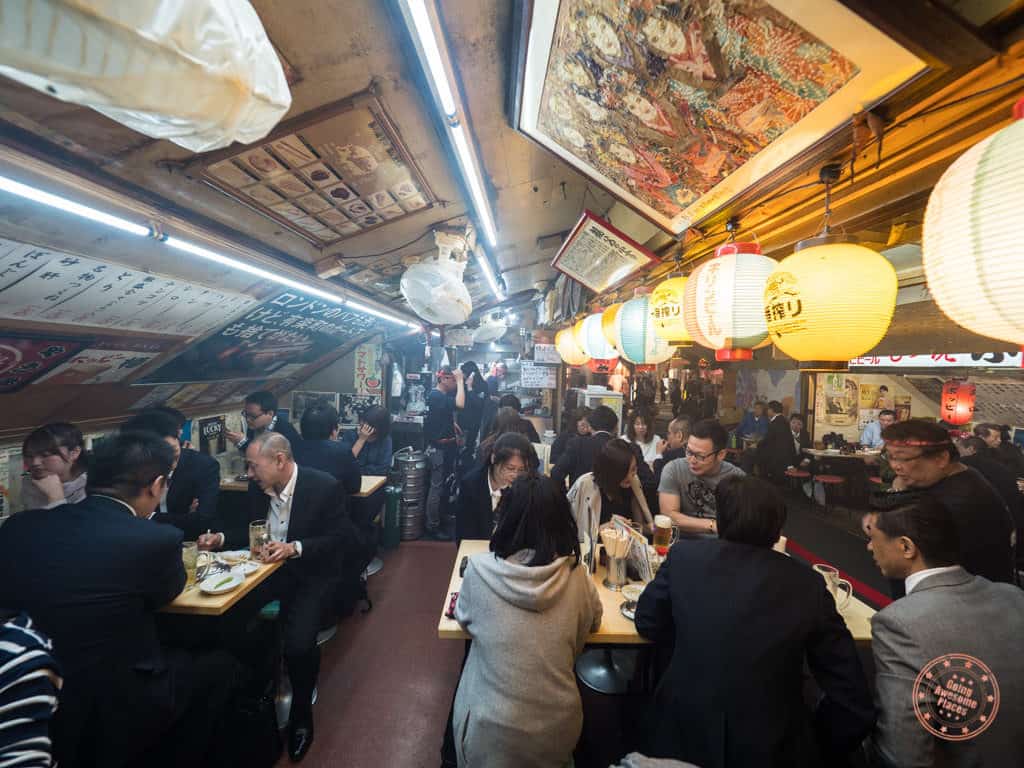
If eating meat on sticks and drowning them in beer sounds like your thing then you have to add this spot to your list of restaurants. There’s no livelier and more local place than this hole in the wall, under the train tracks, yakitori restaurant.
When we came out of Shimbashi station to look for this place, we weren’t sure if we were heading the right direction but we continued to follow the raised train tracks and all the restaurants below them till we started hearing more noise. When we found this busy throughway and matched the characters, we knew were at the right spot.
With small tables stretching out onto the walkway, smoke billowing and desperate to reach open air, the clanging of glasses, salarymen roaring in conversation, and sizzle from the grill, we anxiously waited in anticipation for our table.
Luckily for us, it wasn’t long until two other tourists finished and we got our spot. Overall I’d say the crowd was mainly local but the word has definitely gotten out to travellers so you’ll see them scattered around. That said, the place isn’t big at all. If you watch the video, I don’t think it could fit more than 25 people.
Thanks to the English menu we were able to put our order in pretty quickly and one by one, succulent skewers of chicken, pork, meatball, gizzard, green pepper, alongside takowasabi (diced octopus in wasabi – omg the best), and beer on tap came to our table. It was heavenly.
What made it such an awesome experience was that we were eating with all of the other salarymen and women that had just gotten work, there was a kinetic energy that we could feed off of, and of course all of the skewers we had were grilled just right. Nothing was overcooked. The chicken was so good that we ordered a second serving.
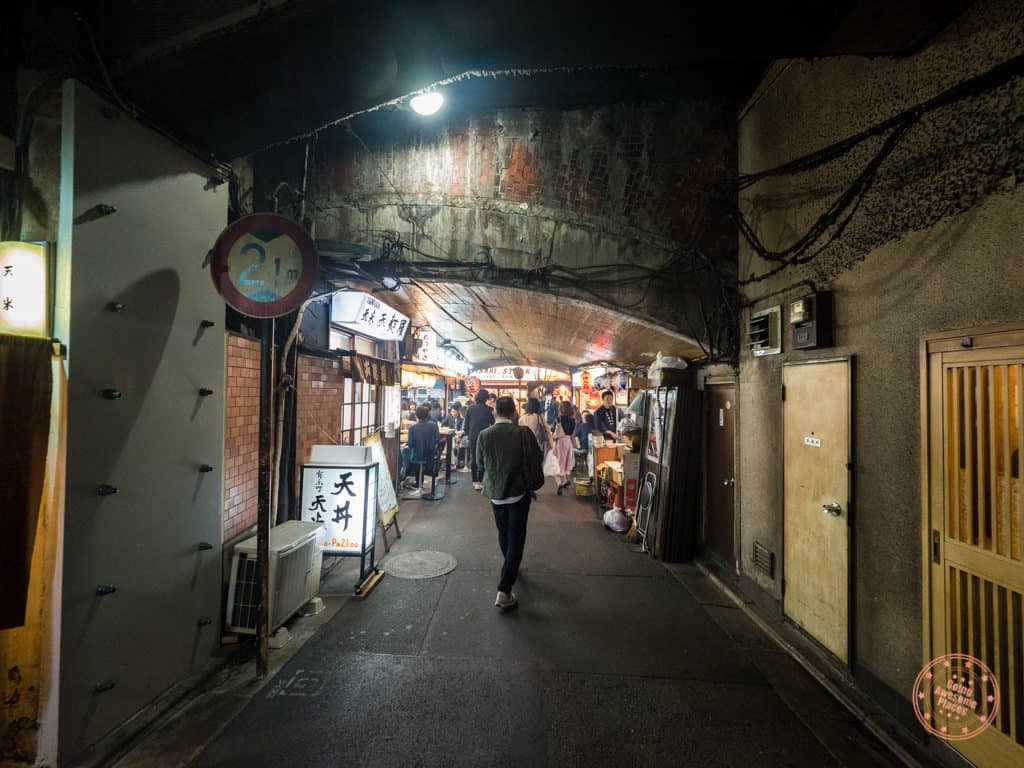
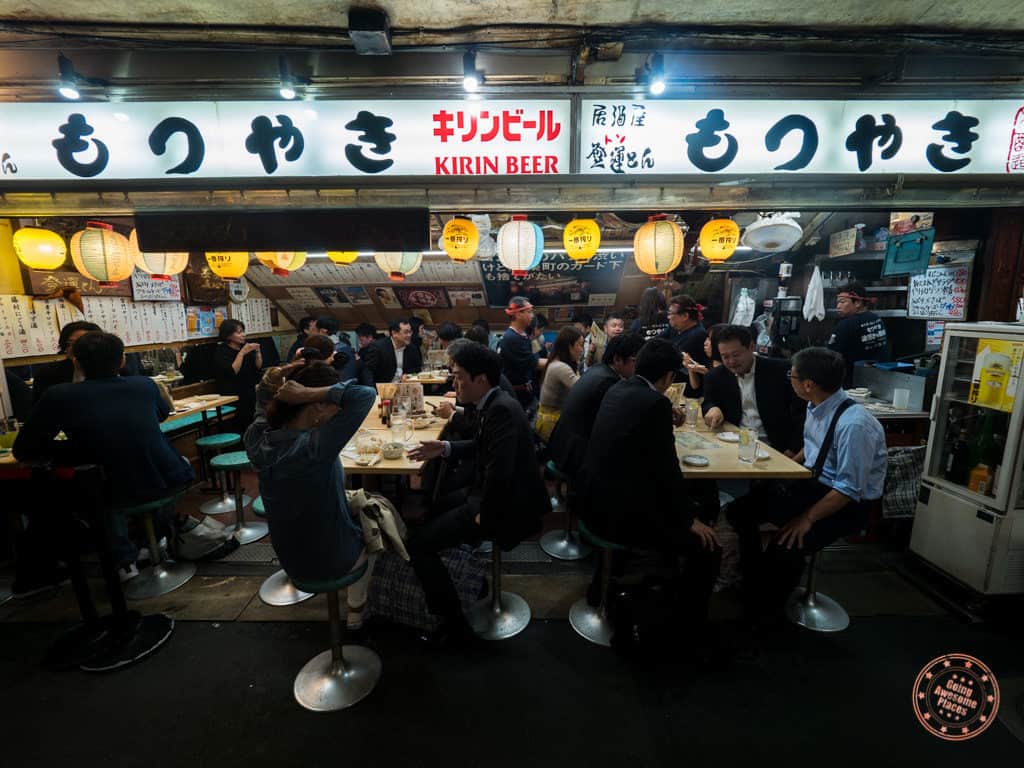
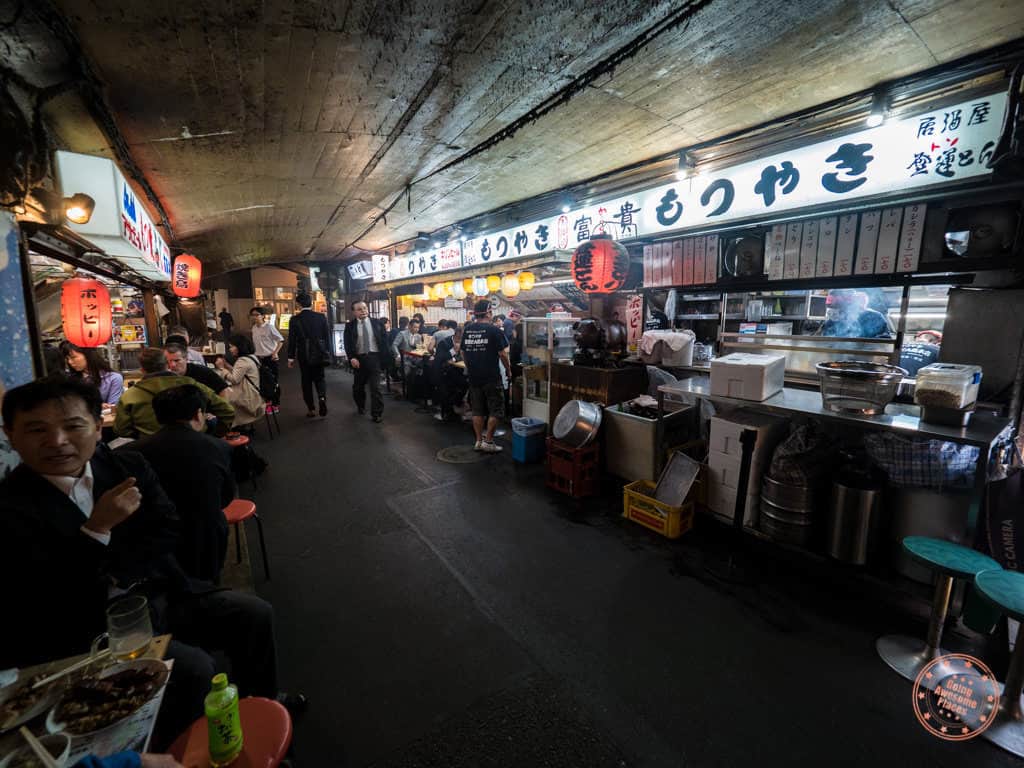
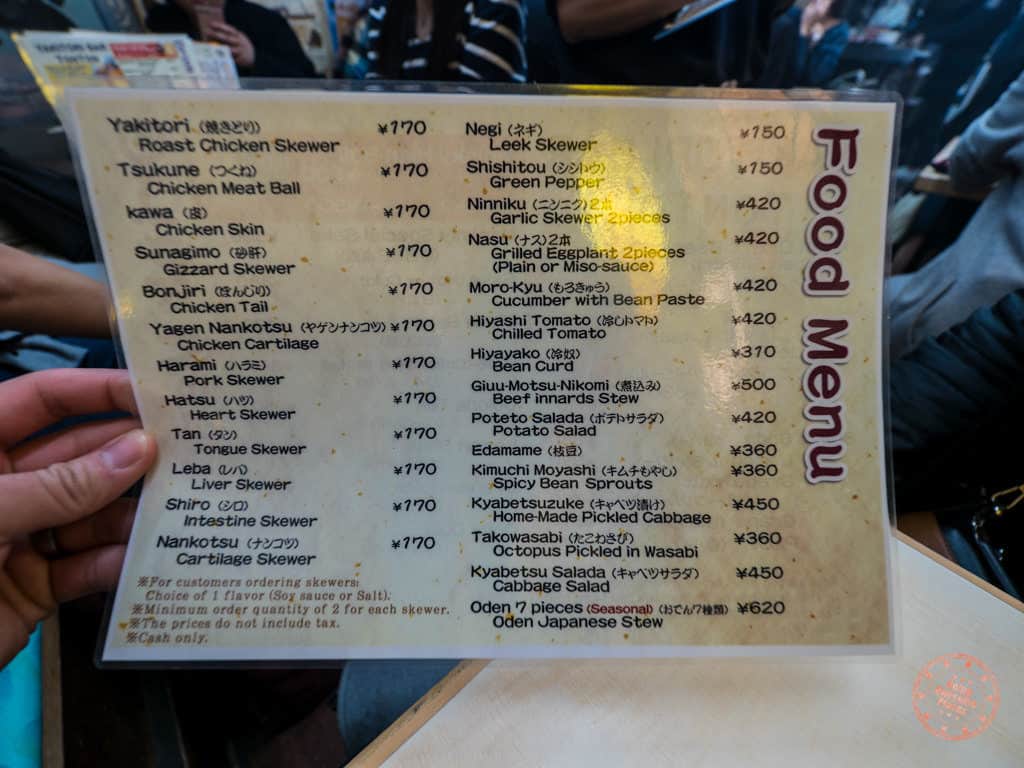

There are two identical yakitori restaurants on this throughway. Only one of them is this one. The other is a different restaurant but from what I saw, I don’t think you could go wrong with either.
Before we were seated, they made sure we understood the rules: 1) Each person must order at least one food item and one drink item 2) When it’s busy, the max seating time is 60 minutes 3) Prices do not include tax 4) It’s cash only.
Neighbourhood: Yarakucho/Shimbashi/Ginza
Open hours: 1PM – 11PM M-Th, 12PM – 11PM F-Su
Address: (See map)
Price: Assortment of skewers, two servings of takowasabi, and drinks (4,276 JPY)
English menu?: Yes
4. Nakaya (仲家)
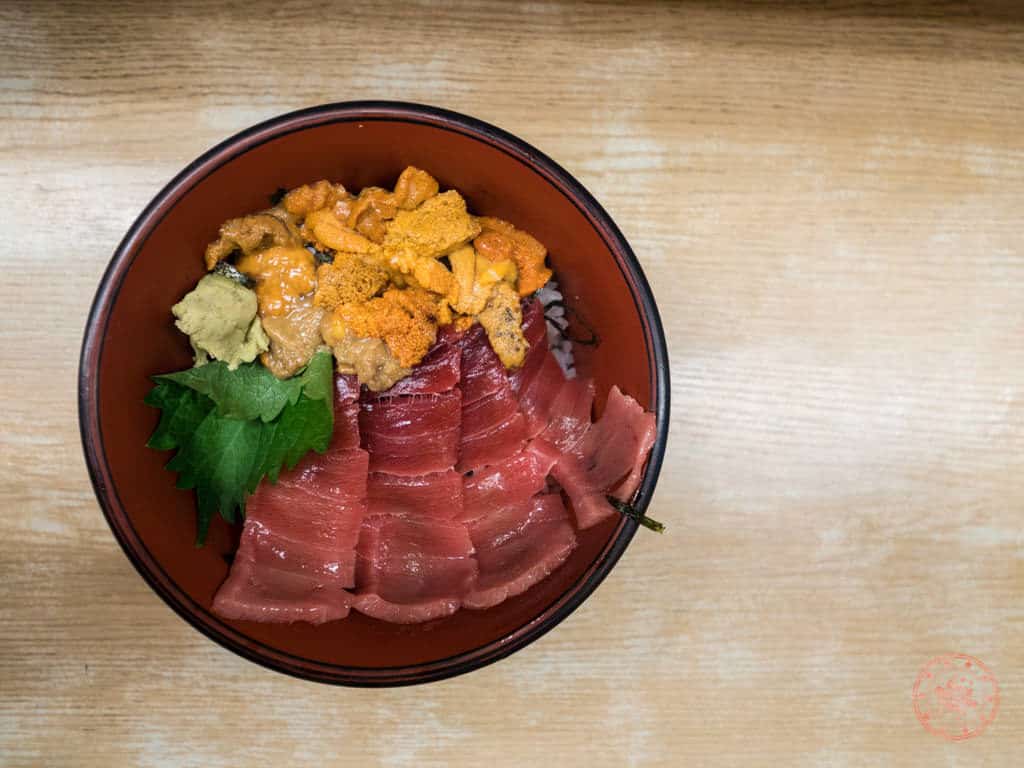
Nakaya is now at Toyosu
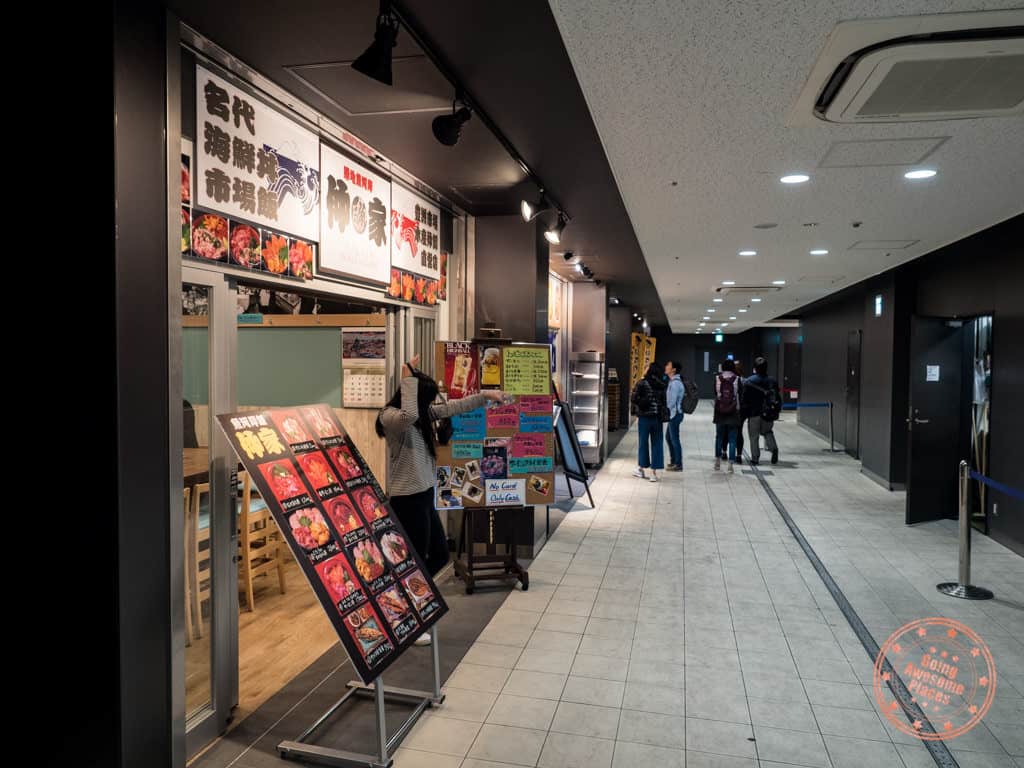
I can confirm that Nakaya has now moved to Toyosu Market from Tsukiji. They can be found in the Fish Intermediate Wholesale Market Building and the floor of restaurants. Saw the same chefs and assistants working there. I’ve kept my description of Nakaya the original from my experience at Tsukiji.
Read more about Toyosu
You could say that Tsukiji Fish Market is a pilgrimage of sorts if you love sushi. Sure there are better and fancier Michelin rated restaurants in Tokyo but a trip wouldn’t be complete without a visit to one of the sushi restaurants here and for breakfast no less.
In a previous trip to Tokyo, we had done Daiwa Sushi which was an amazing experience. It’s one of the two sushi restaurants at the market that constantly get reviewed. This time though, we didn’t feel like getting up at 4AM to get sushi so we instead woke up at 6AM to get to this restaurant at 7AM.
The beauty of Nakaya when we arrived was that there was no line at all. In fact we showed up, gave our order to the lady in the front, and after one couple came out, we were seated inside at counter seats.
Where Daiwa Sushi was that omakase (chef’s selection) style of menu where you got each nigiri one at a time, Nakaya is all about chirashi which means sashimi on a bowl of rice.
Our bowls came out lightning fast and the fish as fresh as it gets. I personally thought the toro was better at Uoriki Kaisen Sushi but the uni was insanely good here.
The only thing I found was that the service at Nakaya wasn’t the most friendly especially for foreigners but that might’ve been because of all the photo and video I was doing there.

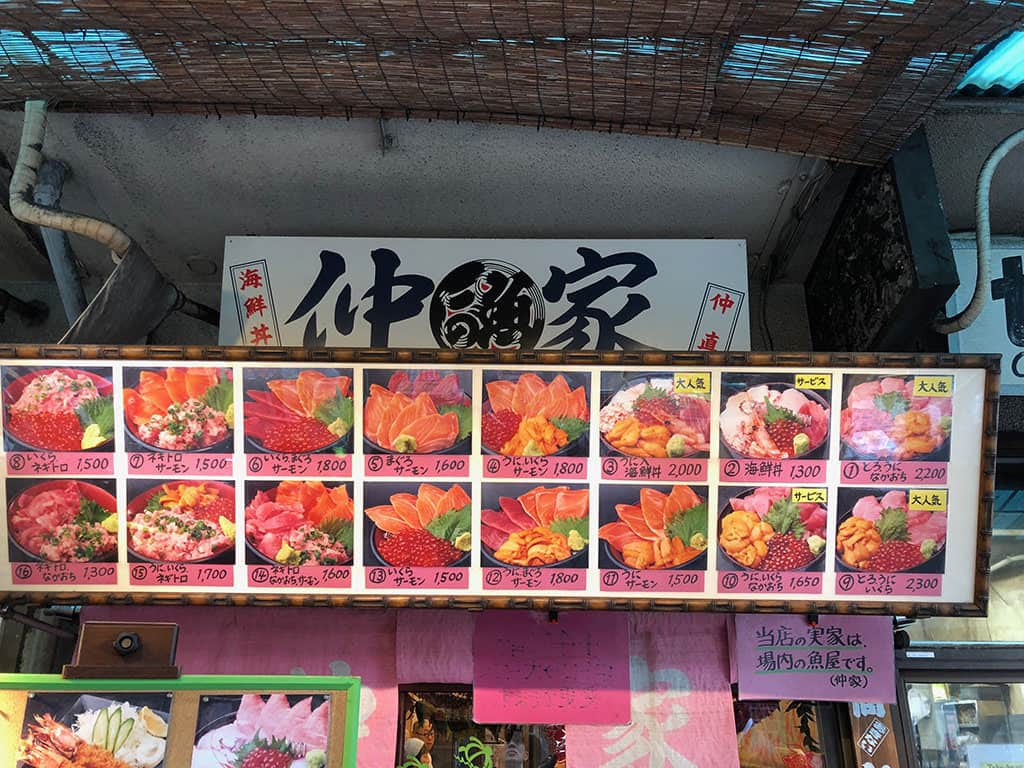
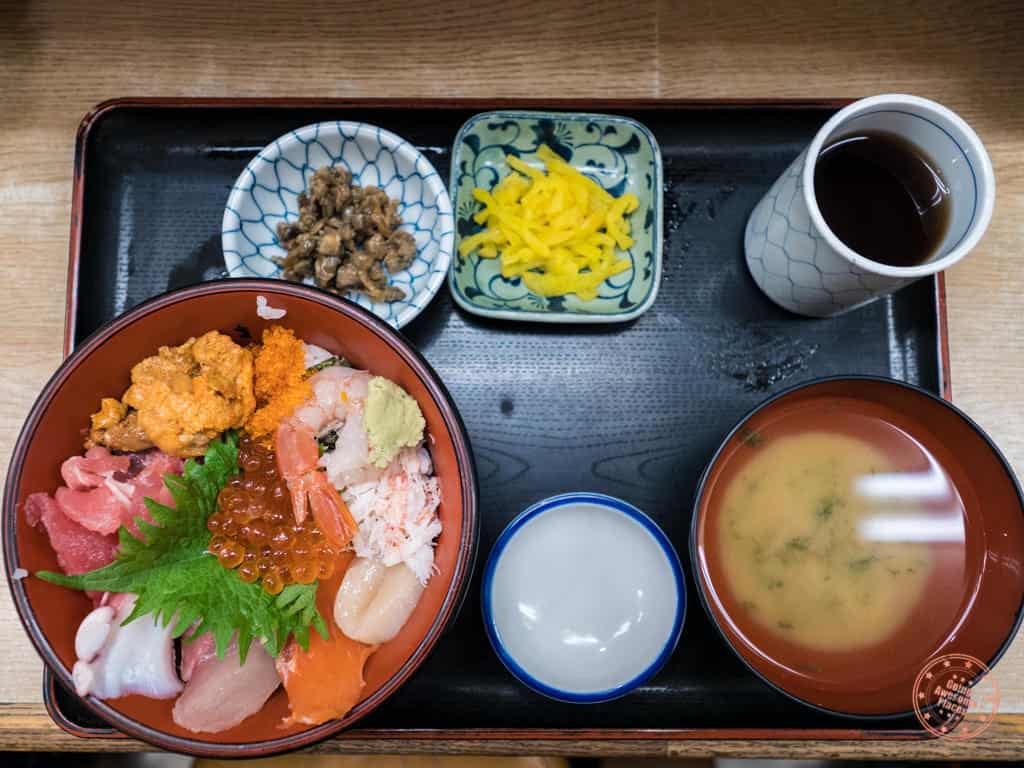
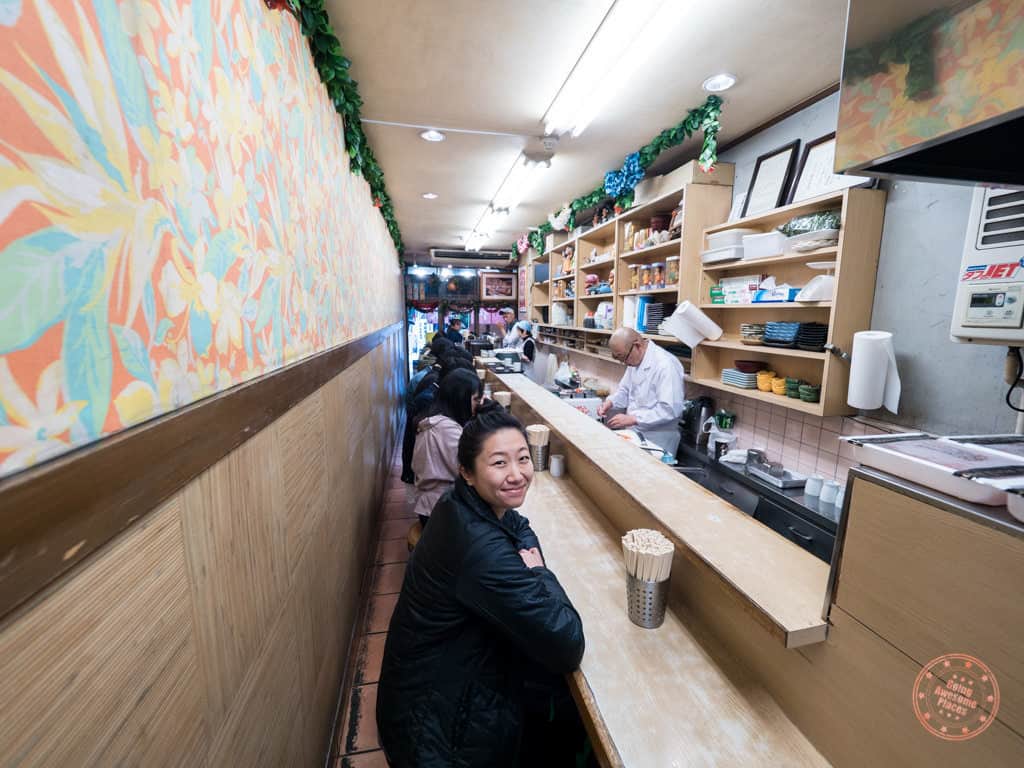
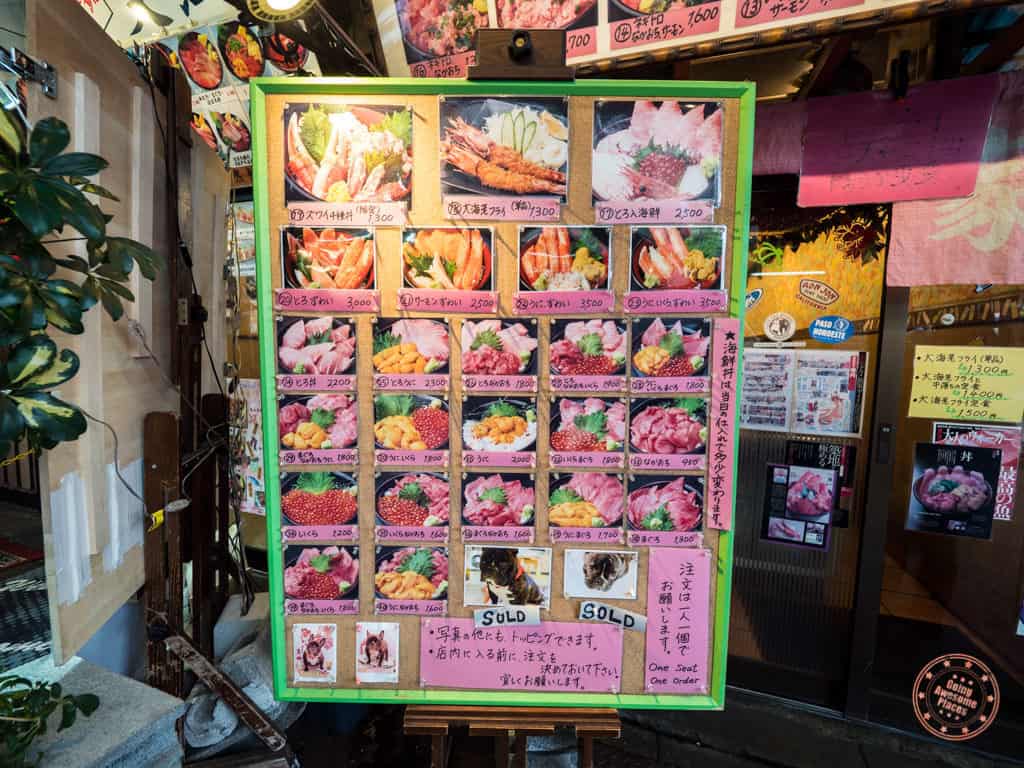
Neighbourhood: Toyosu
Open hours: 5AM – 2PM M-S (closed on Sunday and holidays) (these are the old hours at Tsukiji)
Address: (See map)
Price: Mixed sashimi chirashi (2,000 JPY – $19 USD) and uni + toro chirashi (2,300 JPY – $22 USD), Cash only!
English menu?: No, but there is a huge menu with pictures at the entrance so just point and order
All the details about Toyosu Fish Market
If you want to get the lottery tickets to see the tuna auction at the Observation Deck level or curious about the buildings that are spread out including where Sushi Dai and Daiwa Sushi are, make sure to head on over to a new detailed post all about how it works.
5. Sometaro Okonomiyaki (染太郎)
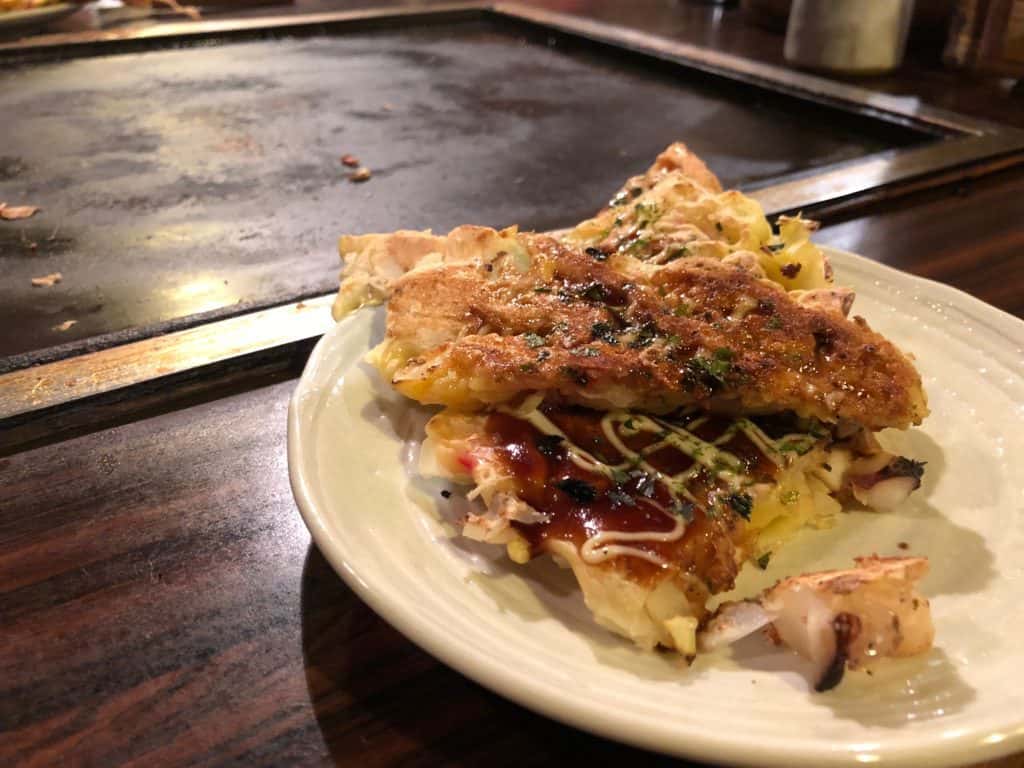
Okonomiyaki is a savoury Japanese pancake that you have to have in different parts of the country because every region has their own take on this popular dish. The Kansai region (Osaka) and Hiroshima are said to be the place or origin but if you don’t make it out there, you should definitely have it in Tokyo.
What makes the okonomiyaki experience so unique in Japan is that restaurants that specialize in it allow you to make it yourself. That’s good or bad depending on how you look at it. Do you really trust yourself to make okonomiyaki?
Regardless, it’s a really fun experience especially at a restaurant like Sometaro which is rebuilt to be in the atmosphere of the Showa period. Stepping inside is a bit like going back in time with nostalgic posters on the wall, photos everywhere, and well-loved and aging tatami flooring, and mini teppanyaki griddle.
Okonomiyaki is essentially a mixture of tempura batter with a variety of ingredients depending on what you order. They come in a bowl and the rest is up to you. Following the instructions in the menu, you melt something like butter on the hot plate before pouring the batter on in the shape of a pancake. The key is to split the batter in two, otherwise it’s too difficult to flip. Once it’s done, you decorate it with mayonnaise, teriyaki sauce, and seaweed flakes. Using the spatula you split it up like a pizza, serve, and enjoy!
The two types that we ordered were Gomokuten which is essentially the house special with seafood and minced meat and Mochiten which was pretty unique with corn, rice cake, and cheese. Both were super tasty and loved Mochiten because you know I love my mochi.
I’m not going to lie, this is a touristy area because of its popularity. In the area that we sat near the back, it was all foreigners. That said, I loved the ambiance of the place and being on a bit of a culinary adventure of trying to figure out how to make something on your own. It was funny how we totally screwed up our first okonomyaki but figured it out with our second one.
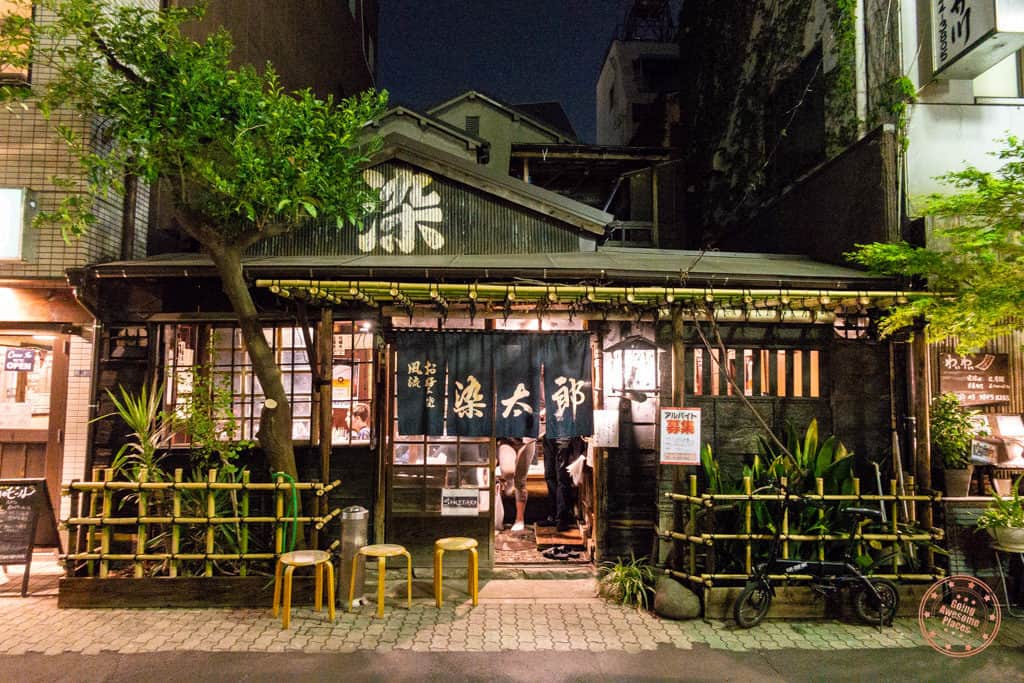
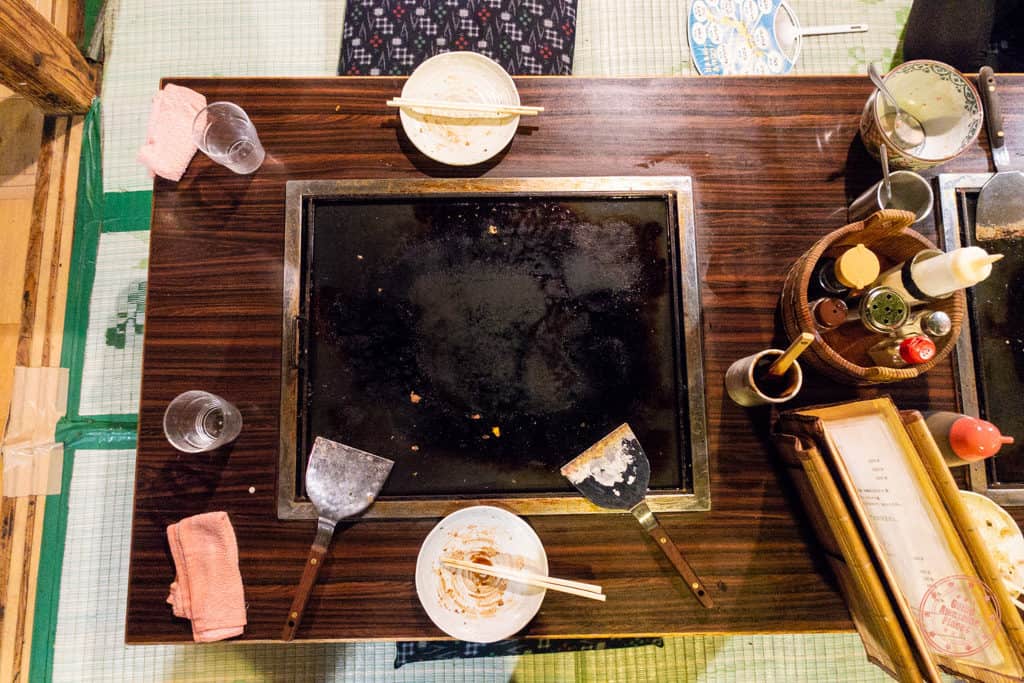

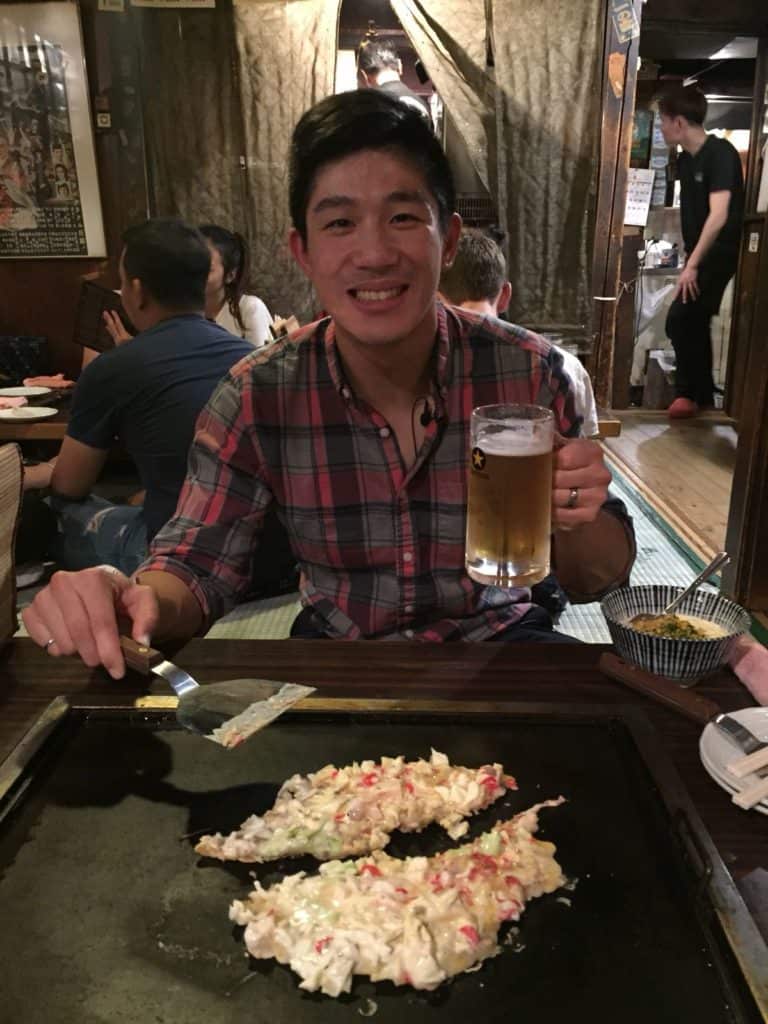

Water is free and at the back of the restaurant. On the rack you can grab a cup and fill it up yourself.
They will ask you to take off your shoes ahead of time. There are plastic bags at the front where you’ll be able to put your shoes to bring inside.
It gets hot there with all of the griddles going. They provide handheld fans just for this reason so be prepared to peel of a few layers.
Neighbourhood: Asakusa
Open hours: 12PM – 10PM daily
Address: (See map)
Price: Gomokuten (870 JPY – $8 USD) and Mochiten (760 JPY – $7 USD) + Sapporo
English menu?: Yes. Waiters know English as well.
6. Tempura Shinjuku Tsunahachi Ginza (天ぷら新宿つな八 銀座店)
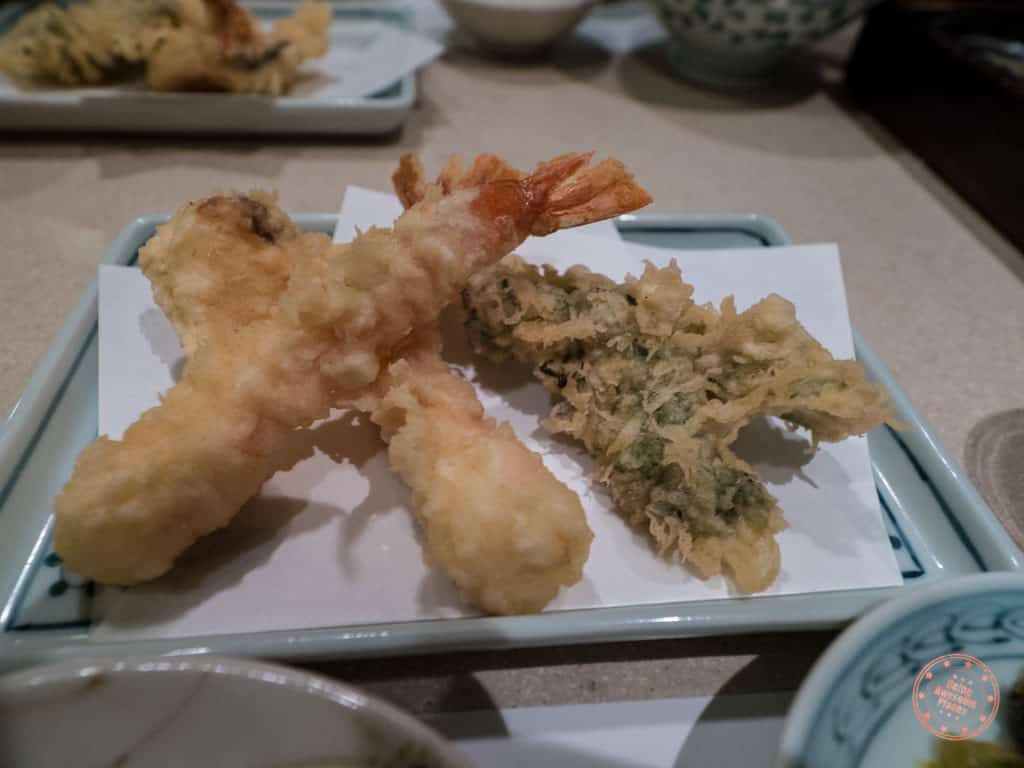
Battered and fried seafood, meats, and vegetables is a mainstay of Japanese cuisine but did you know that it was introduced by Portuguese merchants in the 16th and 17th century? Battered fried food wasn’t a thing until that point in time. Just one of the few things we learned during our walking food tour.
Just like every other type of food in Japan, there’s always the pursuit for perfection and that’s how I discovered this high-end yet affordable tempura experience. Founded in 1923, Tempura Tsunahachi built its reputation on using the freshest ingredients and highest quality tempura in Tokyo. Starting in Shinjuku, they now have a total of 7 locations around Japan. We elected to go to the newer Ginza location.
With a ton of heritage, and frequented by kabuki actors and baseball players over the past century, you’d think things would be ridiculously expensive but for lunch it really isn’t. Showing up at 3:30PM on one of the top food floors of the Matsuya department store, we were seated immediately and found ourselves to be one of the few guests there.
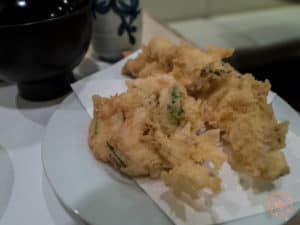
We were presented with English menus but the choices were pretty simple with their lunch set menu that all had a combination of tempura’ed fish, shrimp, vegetables, and kakiage (mixed veggies, onion, and shrimp). I’m sure there was an a-la-carte menu but they didn’t bother showing us as foreigners. We both ordered the 6 piece set, mainly because it was the cheapest option but also the fact that we had sushi only a few hours earlier. We would’ve shared but felt like it would be poor etiquette.
What makes Tsunahachi a must-try is because of how serious they are about their tempura. As each plate comes to the table, you’re amazed at how the batter is cooked just enough to be crispy but at the same time not drenched in oil. It’s a nice light mix that they’ve clearly perfected.
To top that off, we were also given a laminated English sheet on the proper way to have tempura. It’s a multi-step process and you realize you’ve been doing it wrong your entire life. I remember thinking to myself “Wow, so this is how tempura was meant to be eaten!”
This was certainly one of our more expensive meals in Tokyo but definitely the best tempura we had on our trip.


Neighbourhood: Ginza
Open hours: 11AM – 10PM daily
Address: (See map)
Price: Tempura-zen set menu (2,160 JPY – $20 USD)
English menu?: Yes
7. Tokyo Station Ramen Street – Rokurinsha Ramen (六厘舎)
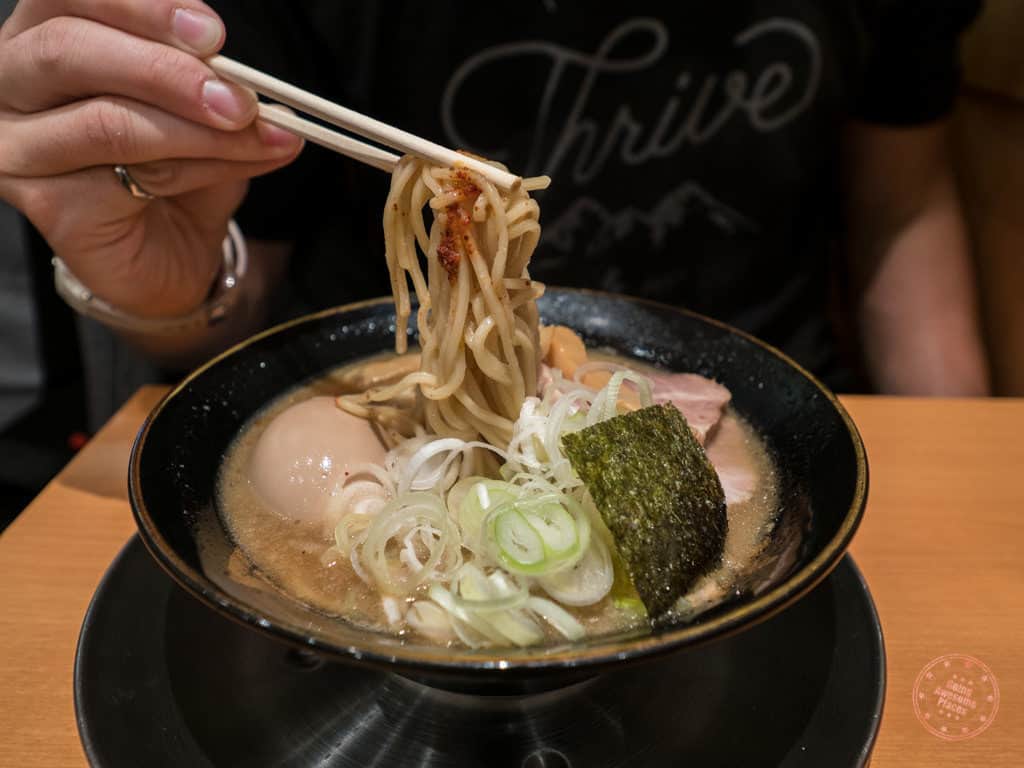
Ramen is kind of an obsession in Tokyo and everyone you talk to will probably have their own take of what is “the best”. Confused by all the choice, I figured it would be easier to go somewhere that had several options to choose from. That’s when I found out about Tokyo Station and their cluster of ramen shops on what’s affectionately called Ramen Street.
The history behind it is that when they built the basement level, they took 8 of the best and most famous Japanese ramen shops from around the country and asked them to open up shop on the street.
We went there not knowing where we’d be eating but of course we got suckered into the one that had a line. After all, Japanese queues are always means that it’s something that’s worth waiting for right? This ended up being Rokurinsha which is right at the main corner of Ramen Street.
We made it right before the off-work rush hour at 4PM and got seated after waiting in line for 20 minutes. We ordered the Special Ramen and Special Dip Noodle as we waited in line as instructed by the waiter directing traffic.
Rokurinsha is known for a type of ramen called Tsukemen style where soup and noodle are separated and the broth is much more rich and the noodles thicker. This is what they call “Special Dip Noodle” in English. Usually we’re pretty open to trying new types of food but the Tsukemen style wasn’t one for us. We found the broth too rich and a little too overpowering in fishiness. This is thanks to the addition of gyofun (dry fish powder). It almost tasted like canned tuna. Sad to say, we didn’t finish the bowl but we did notice that when you’re done your noodles they basically dilute the broth so you can drink it like a soup.
My special ramen on the other hand was fabulous and more of the traditional style of ramen that we’re used to. I found the broth to be just the right level of thickness and oiliness. The egg was done brilliantly with the golden yolk that’s on the edge of being fully cooked through. The slices of pork were generous and the scallions alongside bamboo shoots the perfect combination.
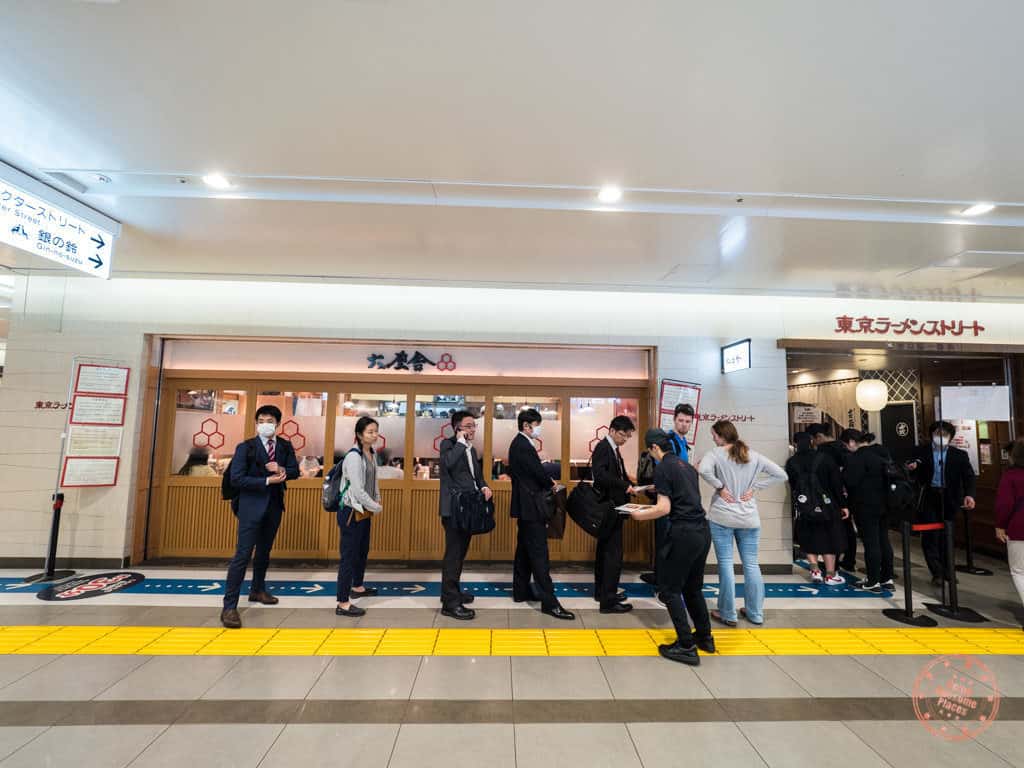
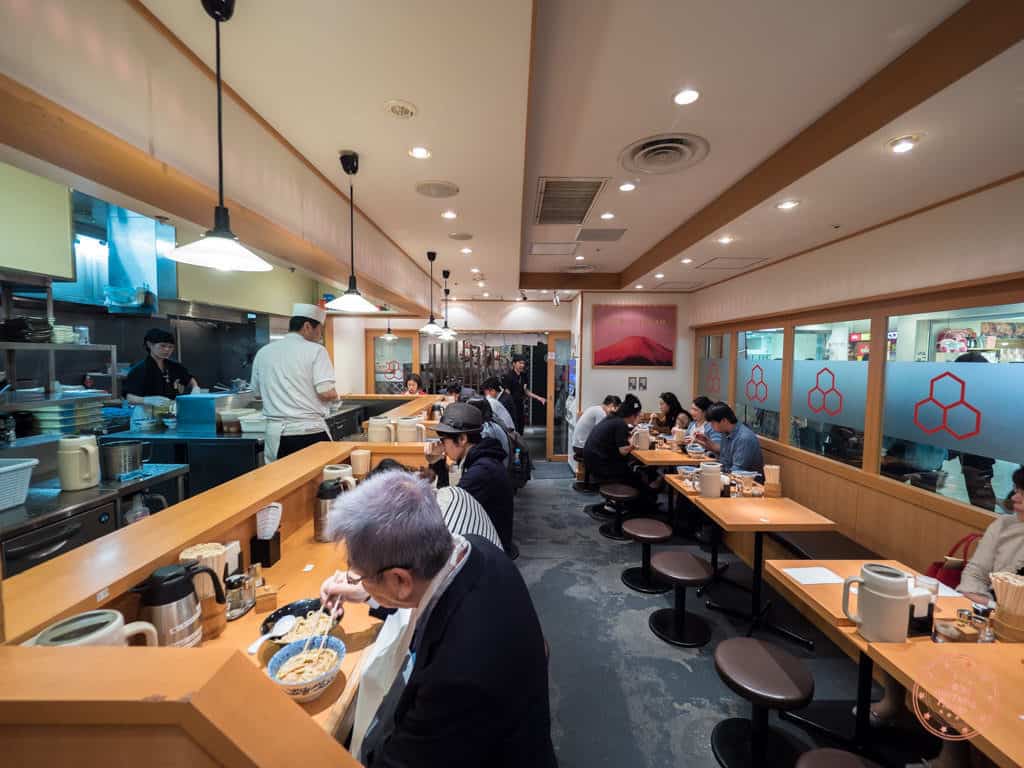
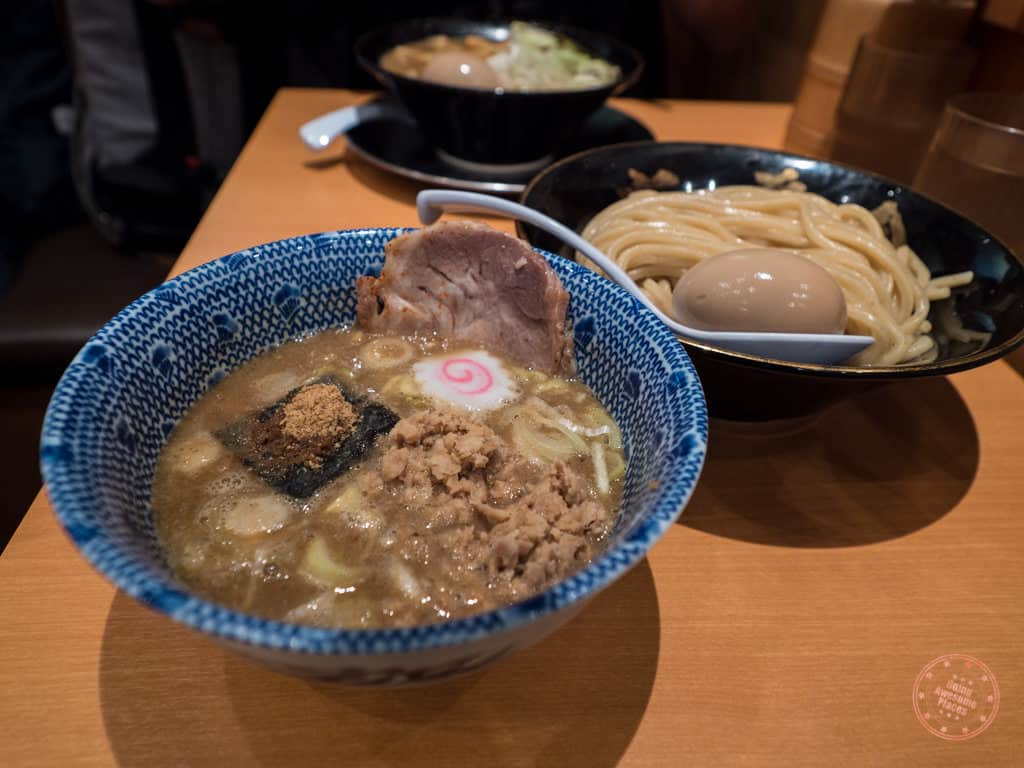
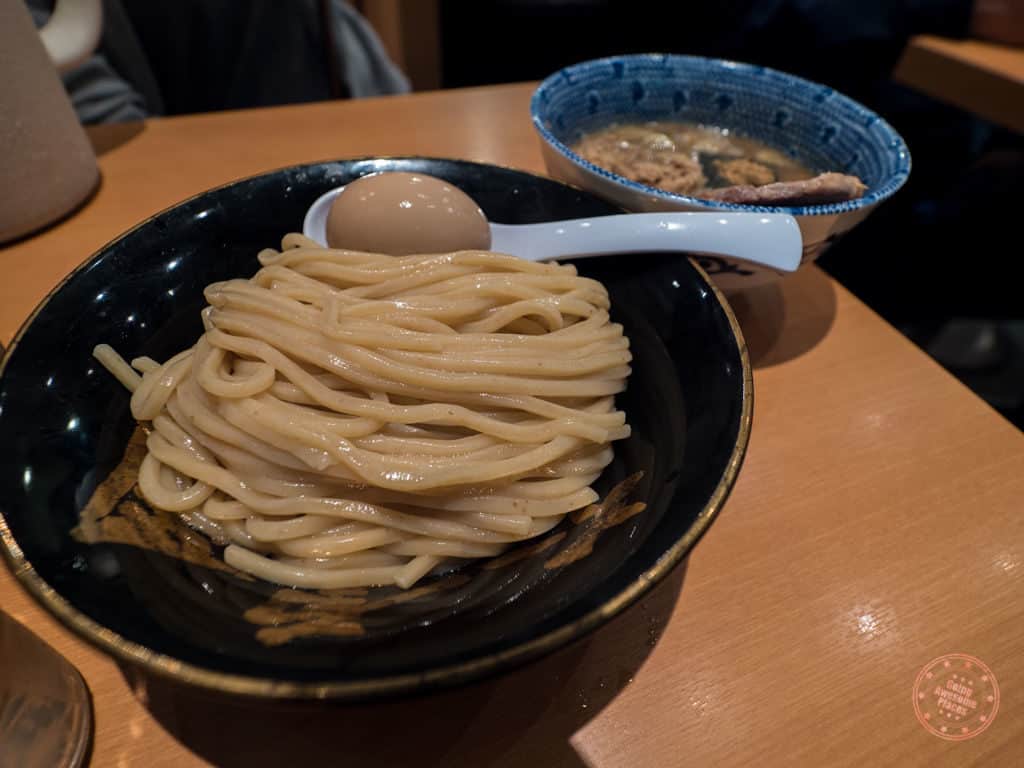
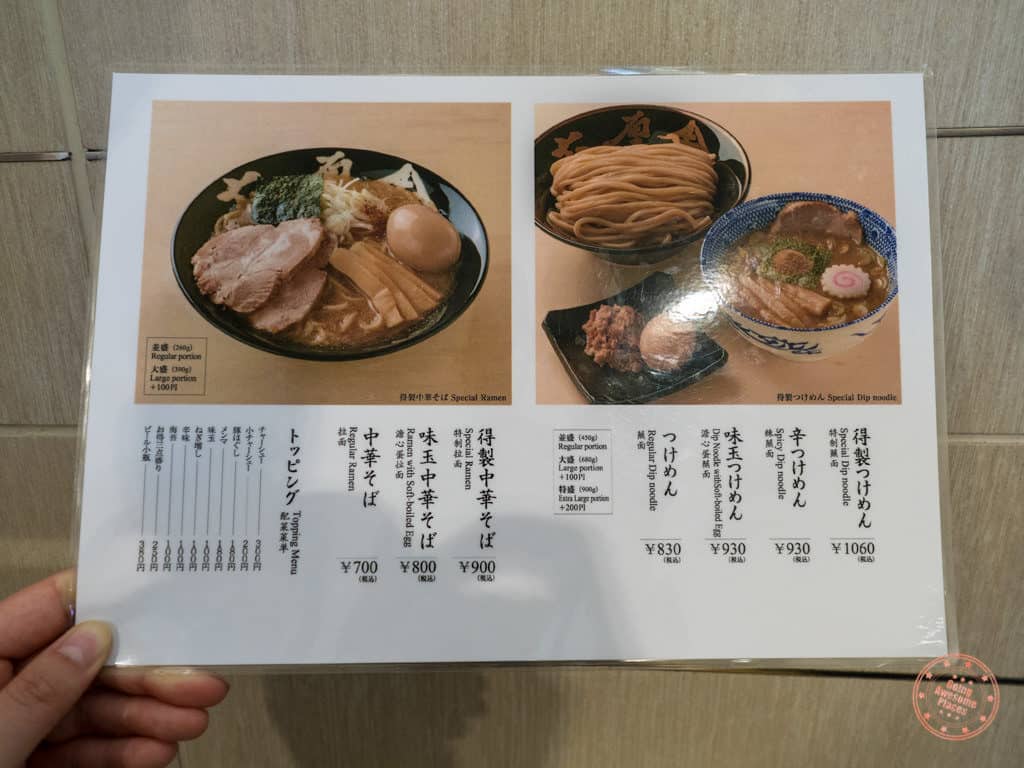
You have to use a machine to order and pay at the vending machine. What’s a little counter-intuitive is that you have to put money into the machine first before pressing the buttons for your order. The ticket that gets printed is what you hand the server when you get your seat.
Neighbourhood: Tokyo Station/Imperial Palace
Open hours: 11AM – 10PM daily
Address: (See map)
Price: Special Ramen (900 JPY – $8 USD) and Special Dip Noodle (1,060 JPY – $10 USD)
English menu?: Yes
8. Memory Lane – Piss Alley (Omoide Yokocho – 思い出横丁)
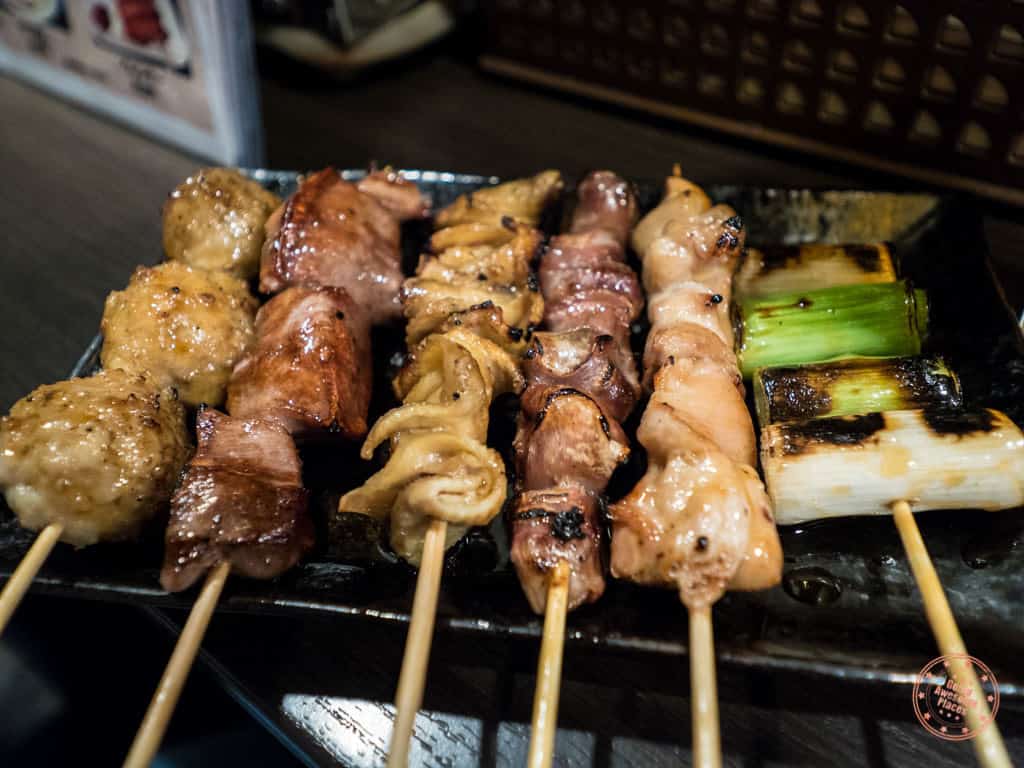
There’s a narrow alleyway next to the bustling Shinjuku station where lots of izakaya and yakitori are had and also where men often relieve themselves after having too many pints. That is how the name Piss Alley was born. Luckily, times have changed and there’s not so much of the namesake happening anymore but it is still a regular place for after work celebrations to happen.
This long alley called Memory Lane is flanked by tiny stalls on both sides where everyone huddles around the bar on tiny stools while the owners grill up skewers. As you walk from one end to the other, everything from the sounds, smells, and visuals are amplified.
There are a ton of restaurants to choose from and from my observation, you really can’t go wrong with any. All of them are as full of character as the next and equally as tight quartered. You kind of just need to pick and see which ones have seats available.
We ended up at one of the bars near the front and ordered 6 skewers and a glass of local beer to wash it down. The seats were barely big enough for my butt but luckily we weren’t shoulder to shoulder with the other people eating there. The skewers themselves were pretty good but definitely not quite as good as Yakitori Ton Ton.
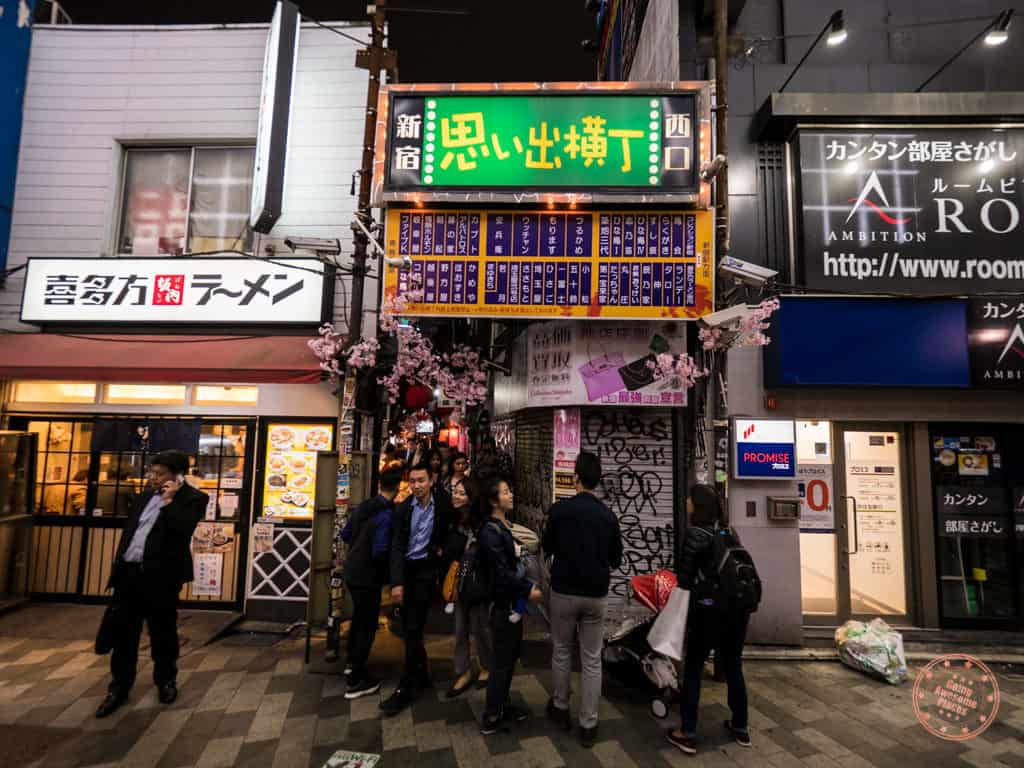
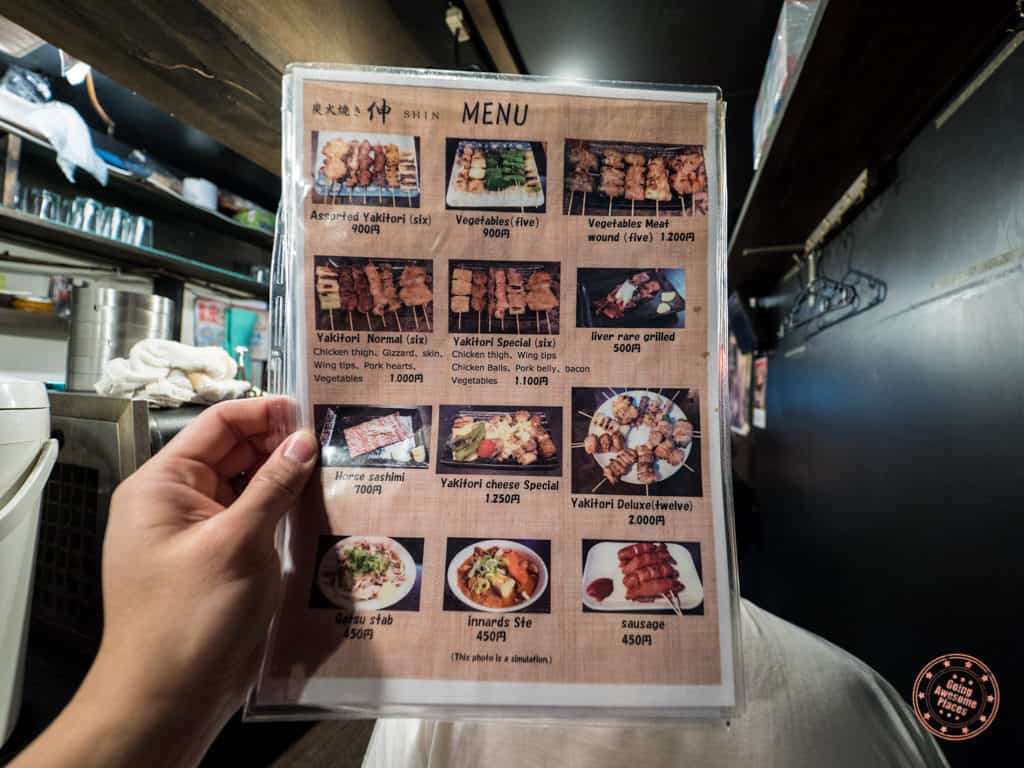
Ordering a minimum of one drink is required.
What turned us off a little was when we got the bill and it was much higher than we expected. Turns out, some of these places automatically charge a “sitting fee”. We later learned that this is to compensate for small spaces and needing to maximize each customer. What they do is sneakily offer you an appetizer which for us was this cold glass noodle similar to Korean jap chae and even if you don’t want it or eat it, it’s 300 JPY on top. That said, it’s one of the few places that we were able to “split” the food so I guess it was fair game.
Neighbourhood: Shinjuku
Open hours: Late afternoon and late into the night
Address: (See map)
Price: Assortment of skewers (2,000 JPY – $19 USD)
English menu?: Yes
9. Motodane (本種)
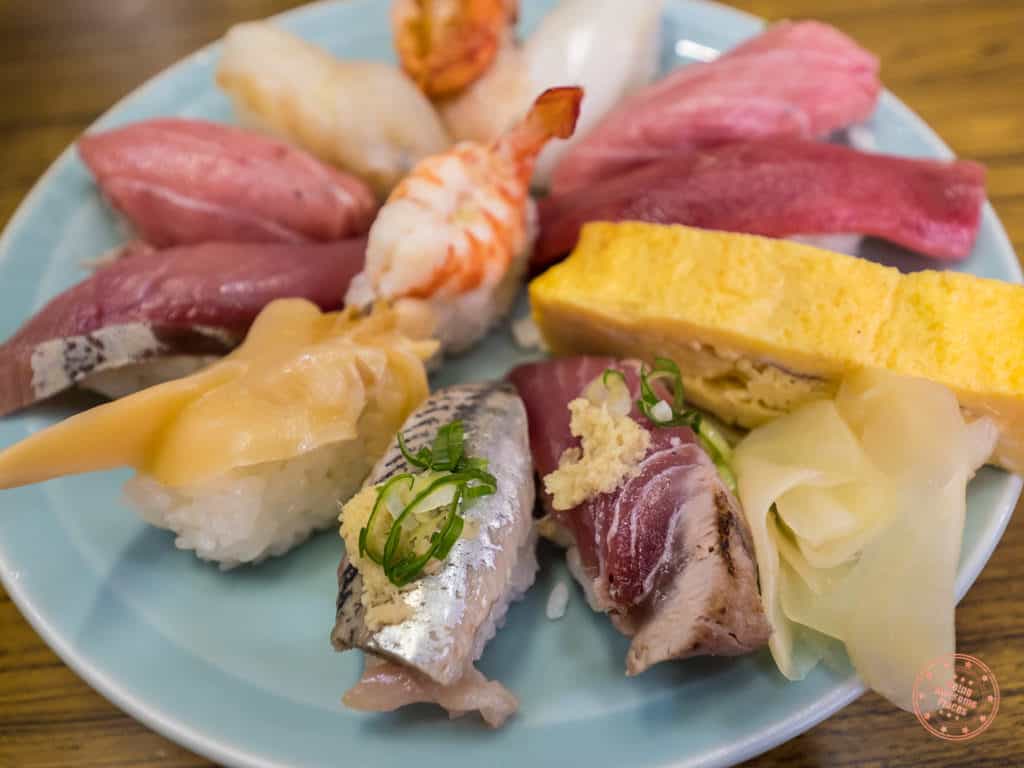
Down a quiet alley on the East end of Tsukiji Fish Market is a sushi restaurant that is so easy to miss that we must’ve walked passed it 3 or 4 times before we finally figured out where it was. The street itself looks more for wholesalers than anything but tucked away is an entrance on a side-alley to this wonderfully local sushi spot called Motodane.
For those that are wondering, yes this is still at Tsukiji!
What we loved about this place is that it is hyper local. Business men on lunch and other locals dined either at the bar or in the back where we were and there wasn’t an English character in sight. To order, they pointed to the menu pinned up on the wall and tried to explain what they were. We could pick up nigiri and sashimi so we were able to figure it out. It also helped that they were preparing meals for other tables so they could kind of point to things.
The chef’s selection of nigiri and sashimi that we ordered was mouthwateringly fresh and the perfect breakfast paired with the miso soup that came with each plate. The only thing missing was uni.
The one knock I had on the place was that the mackerel we had was laced with bones in it which we thought was a bit odd. So sure the experience could’ve been more refined in terms of better slices and selection of fish but for half the price of Nakaya, who were we to complain.
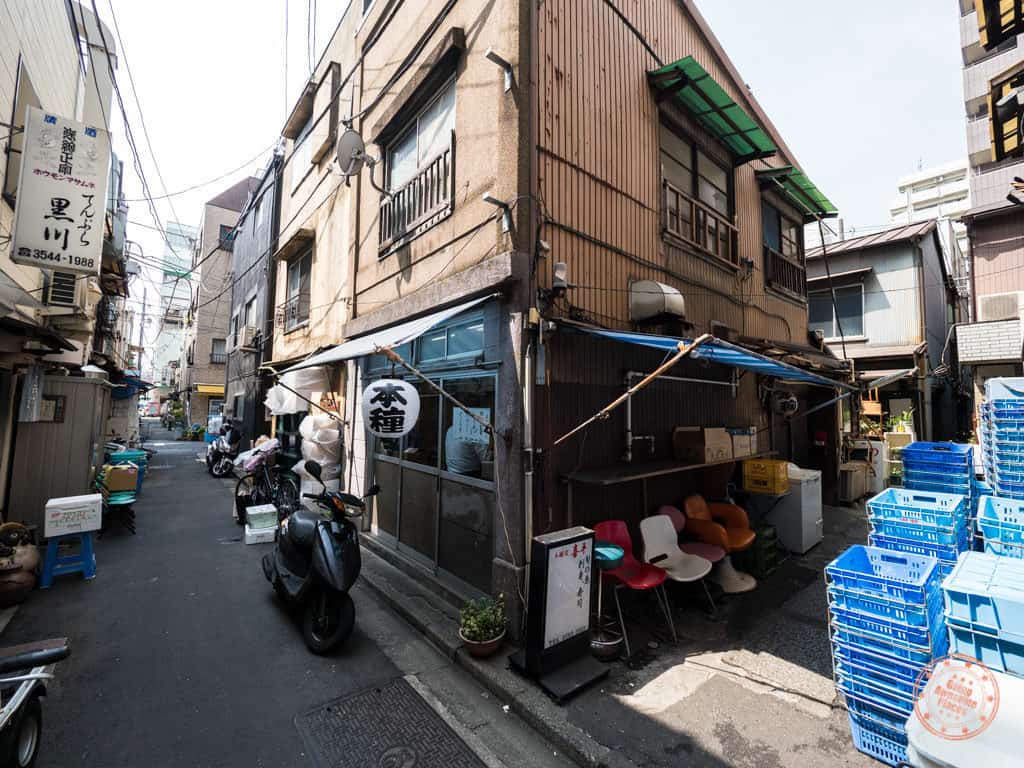
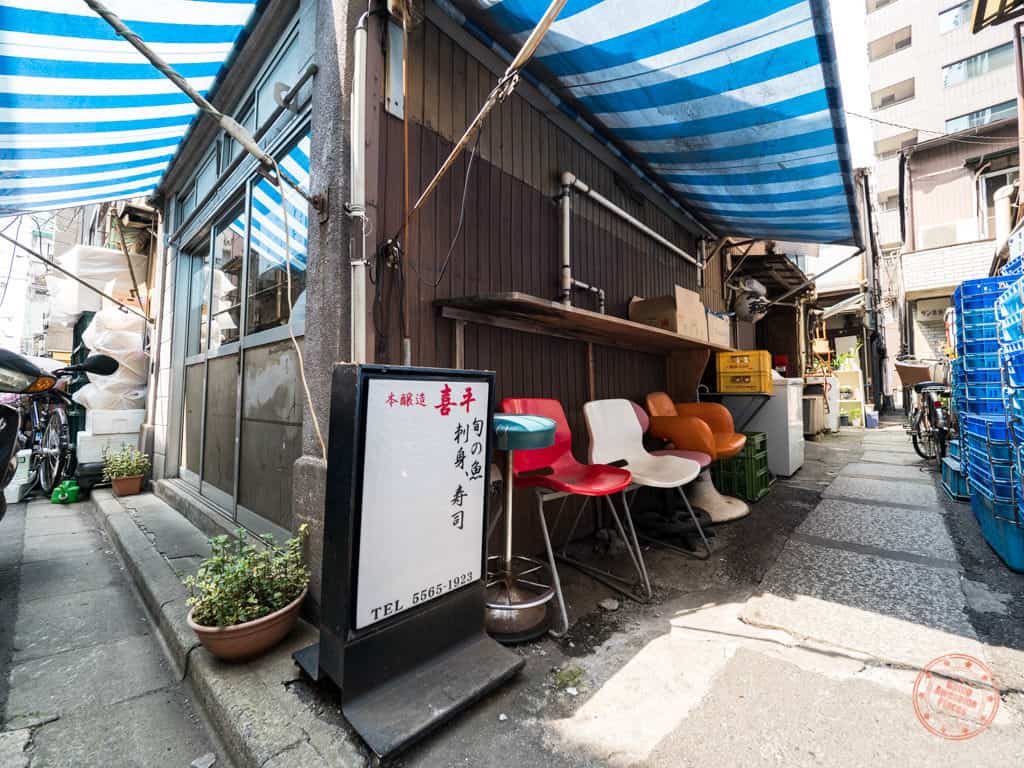
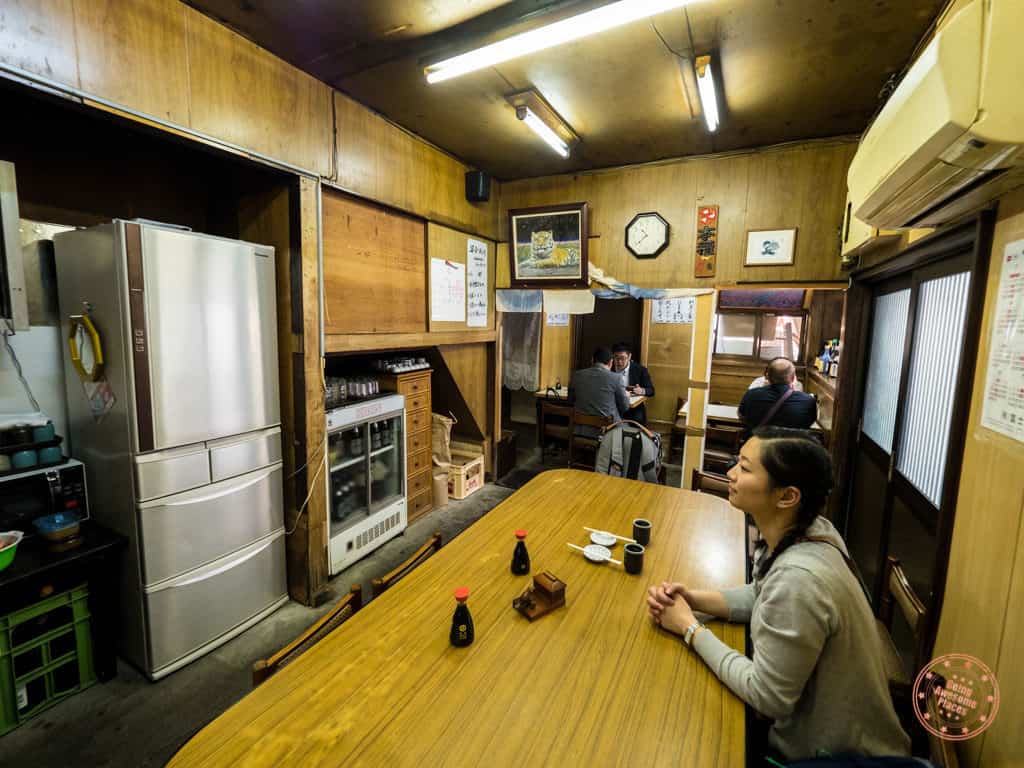
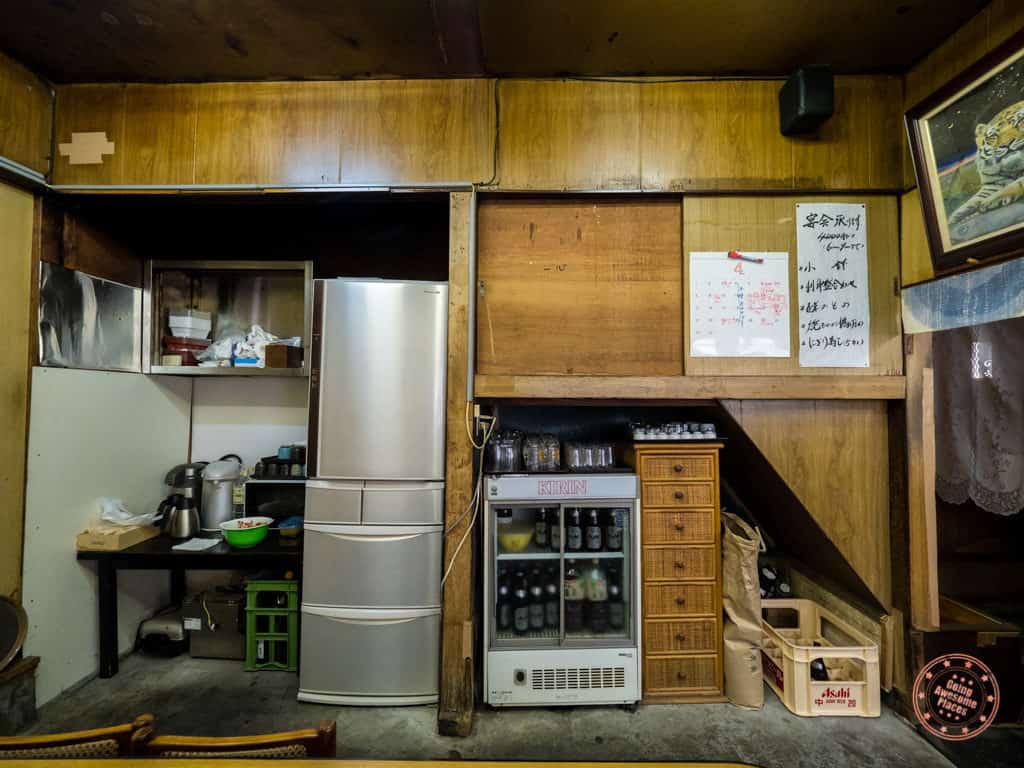
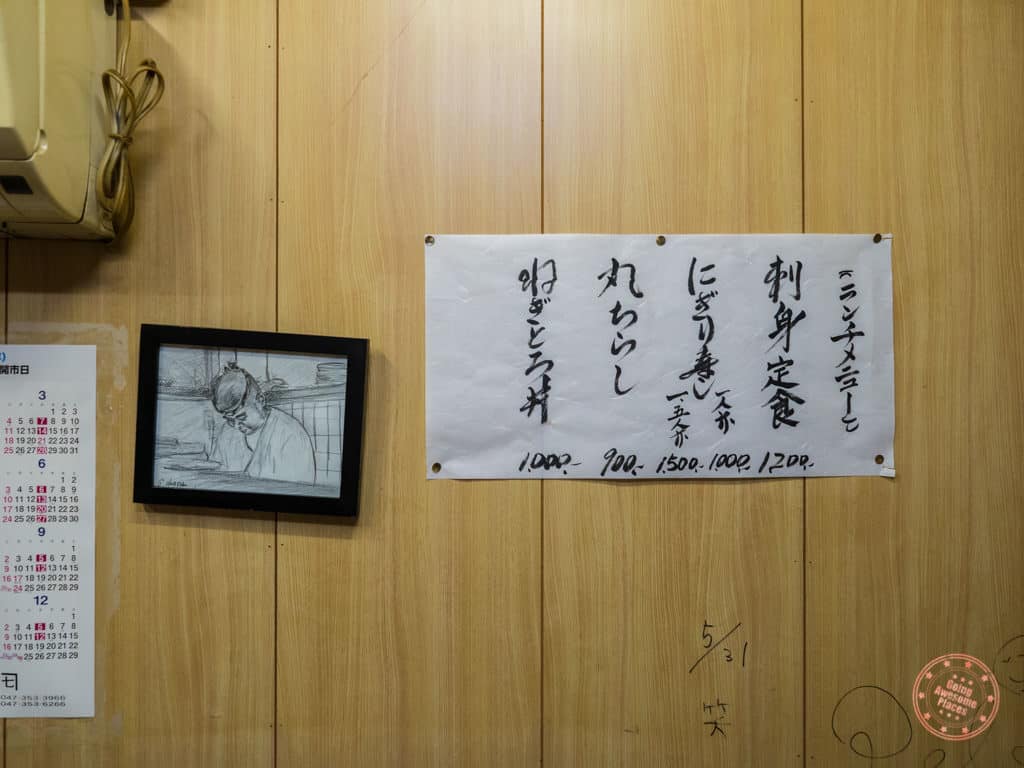
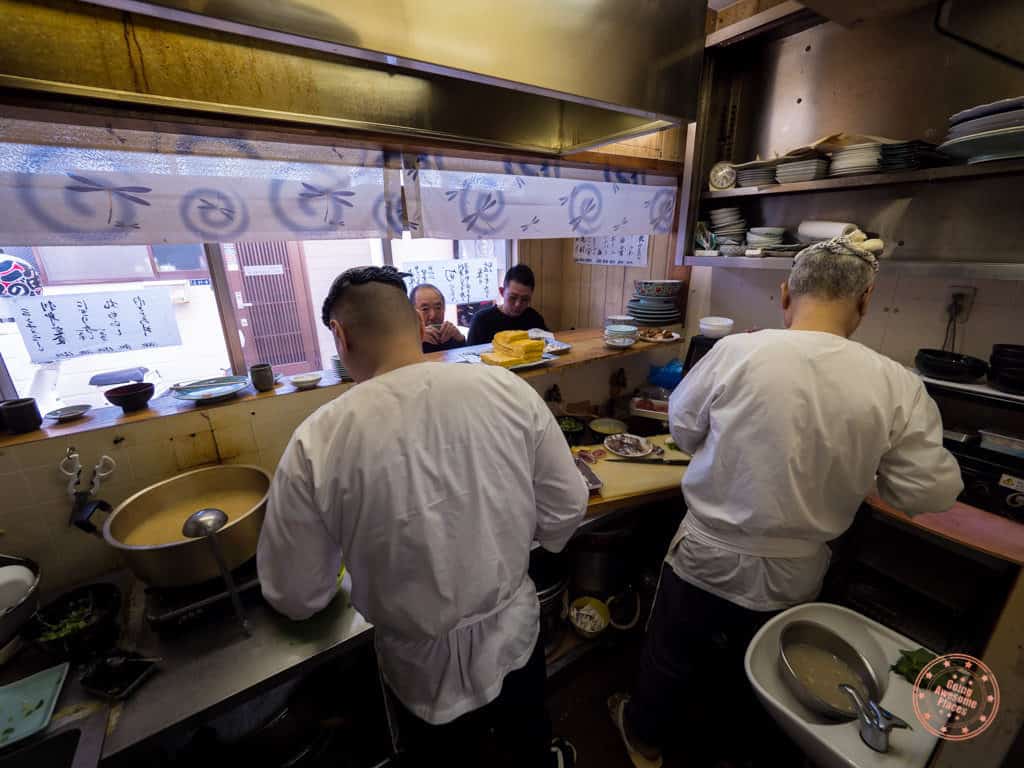
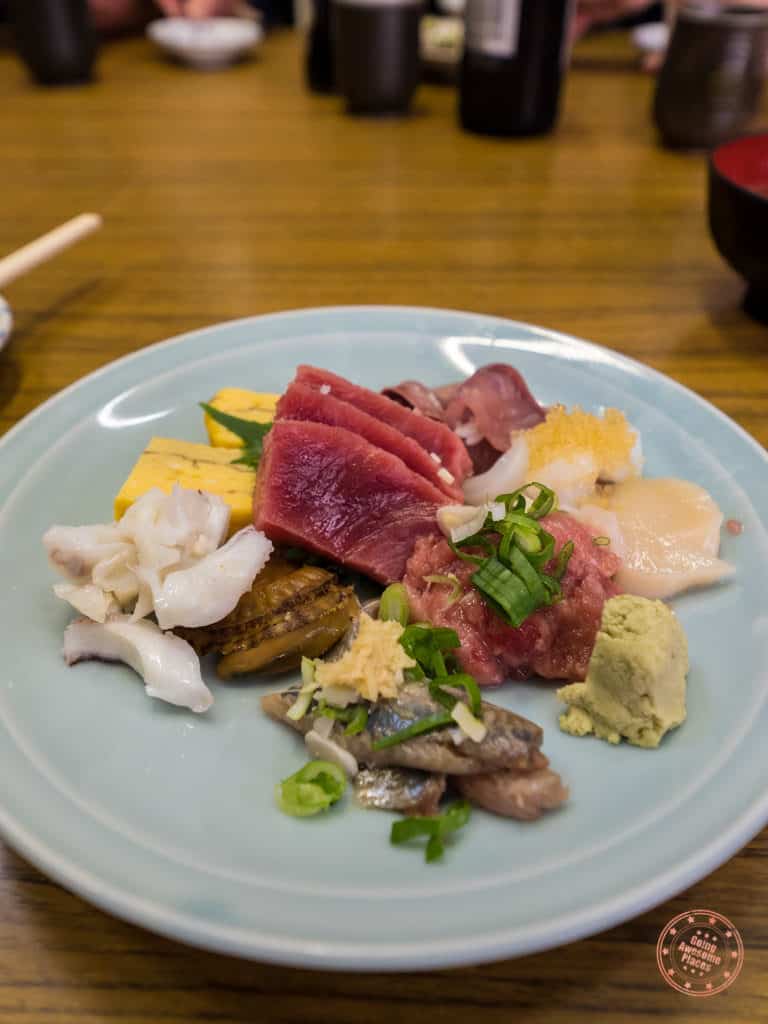
Neighbourhood: Tsukiji
Open hours: Late afternoon and late into the night
Address: (See map)
Price: Sashimi plate (1,200 JPY – $11 USD) and nigiri plate (1,500 JPY – $14 USD)
English menu?: No
Top 5 Dessert Spots in Tokyo
You know I love my dessert too much to not share with you a few of my favourites. It was so easy to find people’s lists of favourite Japanese restaurants in Tokyo but what about the sweet stuff?
1. Flipper’s (代官山店)
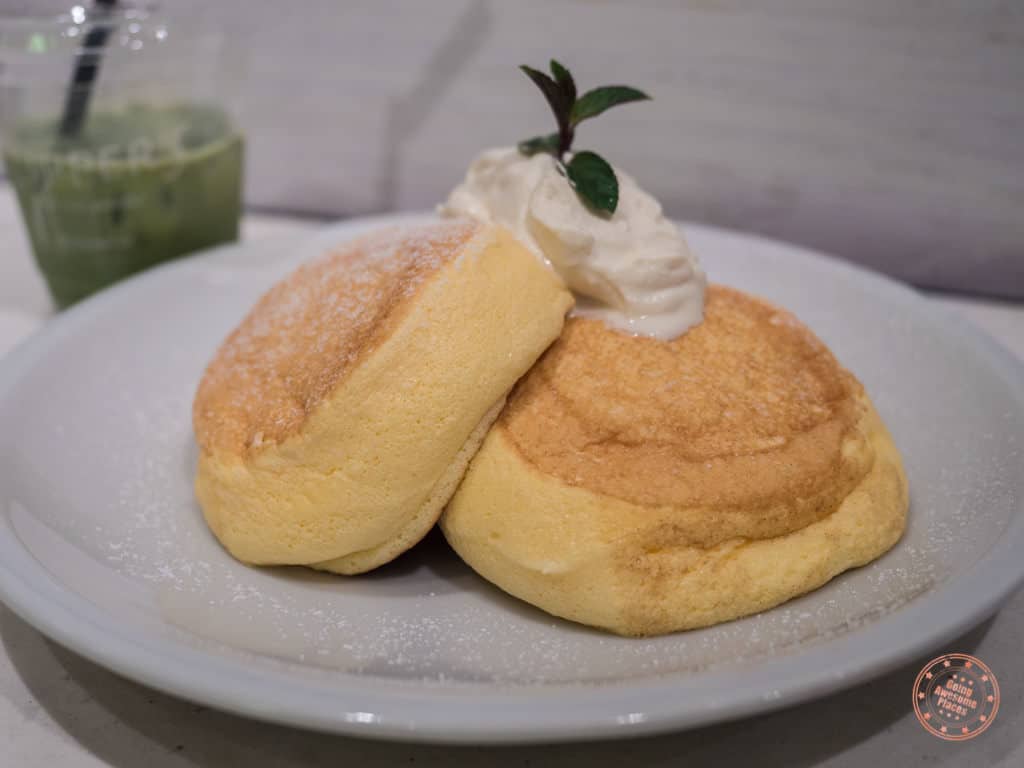
Pancakes are the champions of American Breakfast. In fact, there’s an international house of them. Soufflé is the French art of heavenly light and puffy cakes made with egg yolks and beaten egg whites. What happens when you mix them together in Japan? You get Flipper’s and an all out new sensation called soufflé pancakes.
Topped with special maple butter cream, these super fluffy and melt-in-your-mouth desserts blew my expectations for what a pancake could be. The choices are pretty simple – you can either get them with fruit toppings or without. You’re going to love these airy and delicate creations.
Lucky for us we didn’t have to deal with any mind boggling queues but did have to wait in line for roughly 20 minutes before getting into their Ebisu location. Luckily they had chairs and like all the restaurants that had a queue, they took our orders ahead of time.
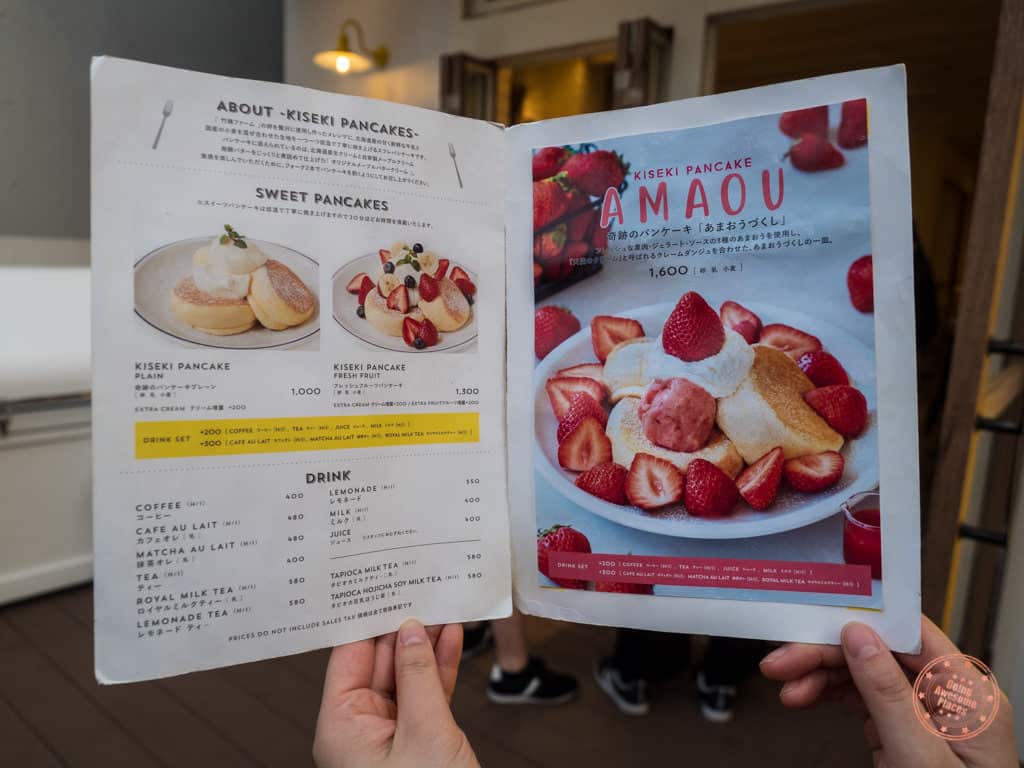

This was one of the few places where we could share a dish but they did make us order a drink.
Neighbourhood: Ebisu
Open hours: 11AM – 8PM M-Su
Address: (See map)
Price: Original soufflé pancake a.k.a. kiseki pancake plain (1,000 JPY – $9 USD) + matcha au lait (400 JPY – $4 USD)
English menu?: Yes
2. Zaku Zaku (ザクザク)
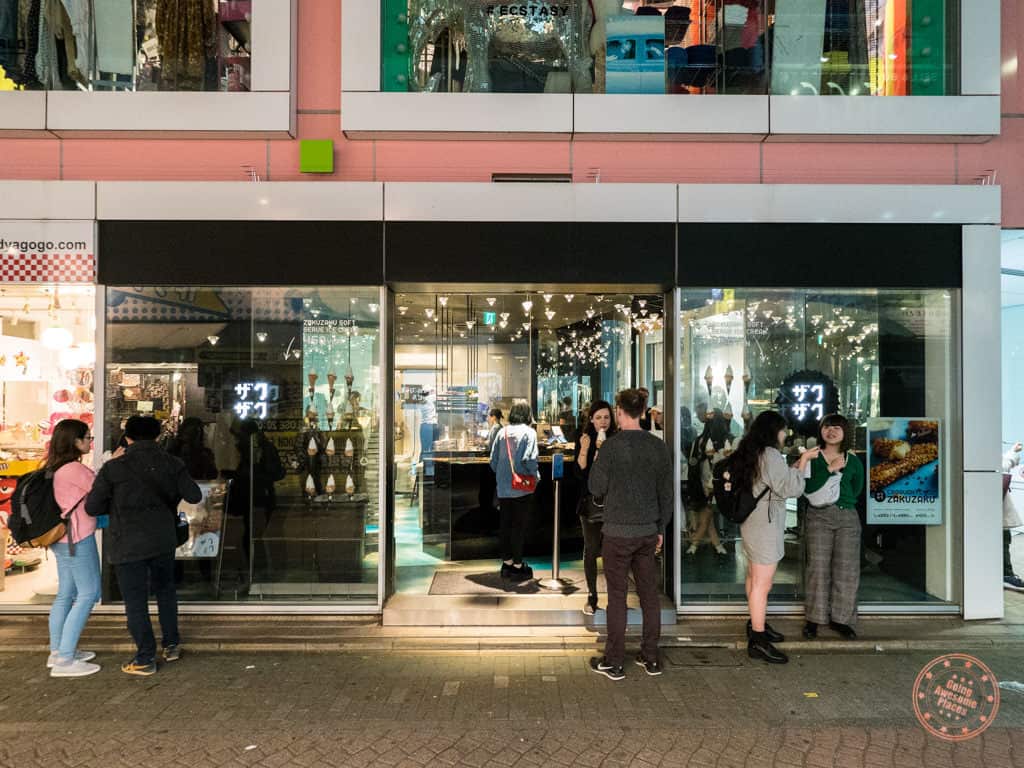
A trip to Tokyo wouldn’t be complete without a visit to character-filled Harajuku. Besides cosplay shops, vintage clothing stores, and colourful street art, you’ll also find a few my favourite dessert spots in the city.
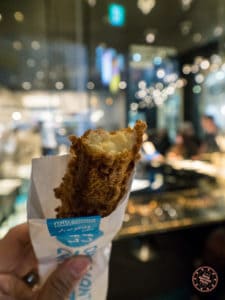
Zaku Zaku was introduced by a friend and they specialize in a unique take on the traditional cream puff that places like Beard Papa’s have been doing for a long time. What they make is something called a croquant chou which are French words for ‘crisp’ and the pastry used for cream puffs and eclairs. Zaku Zaku directly translates to crunchy.
Touting fresh ingredients from Hokkaido, this mashup of cream puffs and eclairs are made of almonds coated with sugar and egg white as well as a blend of Hokkaido-made flour with the cream centres made of milk. They’re all made in-house as they proudly display.
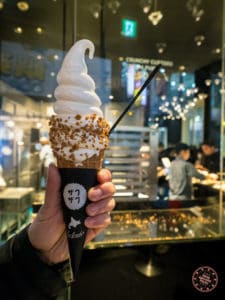
On top of the croquant chou, there’s also their soft-serve which is crowned by crunchy almond at the cone.
One thing you quickly learn in Japan that any dairy product branded as Hokkaido is instantly premium and for good reason because of the simple reason of how legendary their cows are treated which results in creamy and light milk. That said, I was surprised to see that everything was quite affordable here as I was definitely tempted to order more than one crispy cream puff.
Eating the croquant chou right away, I quite enjoyed mine. I think it’s much friendly form to eat compared to the traditional ball of a cream puff that always explodes as you eat it. The crisp is a nice element to it as it is complementary to the soft-serve which was very good. I can’t say it’s going to blow you away but definitely unique and will satisfy your sweet tooth.
There are several locations around Tokyo so make sure you to check to see if there are ones that are more convenient to you.
We showed up at 8PM on a weekday and there wasn’t much of a line. Even if there is one, it moves very swift as it’s very much a pay-and-go system.
When you’re done, think about booking a tour to learn more about the neighbourhood here with the Harajuku Kawaii Fashion & Pop-culture Tour where you’ll learn from a local guide what makes the pop culture here so unique. You’ll be able to have lunch in a crazy monster café and also walk through the nearby Meiji Shrine.
Neighbourhood: Harajuku
Open hours: 10AM – 8PM M-Su
Address: (See map)
Price: Original soufflé pancake a.k.a. kiseki pancake plain (1,000 JPY – $9 USD) + matcha au lait (400 JPY – $4 USD)
English menu?: Yes
3. Tsujiri (辻利)
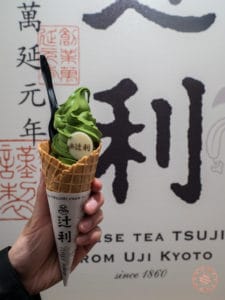
If there’s a #2 behind sushi when you think of Japanese food, I would put green tea in that spot. The most famous matcha comes from a region in Kyoto called Uji but if you’re limited to Tokyo, there are very few options for authentic and high quality tea. We were on the hunt for serious matcha ice cream and that’s when we stumbled upon Tsujiri.
Diving down to the basement floor of the newest department store in Ginza, you’ll be sounding out “ooh” and “ahh” at every turn. This is where you’ll find the highly respected tea shop. At first, we weren’t too interested as we only saw a loose leaf tea on display but we noticed a group of people intensely focused on a cone of matcha soft-serve on the benches.
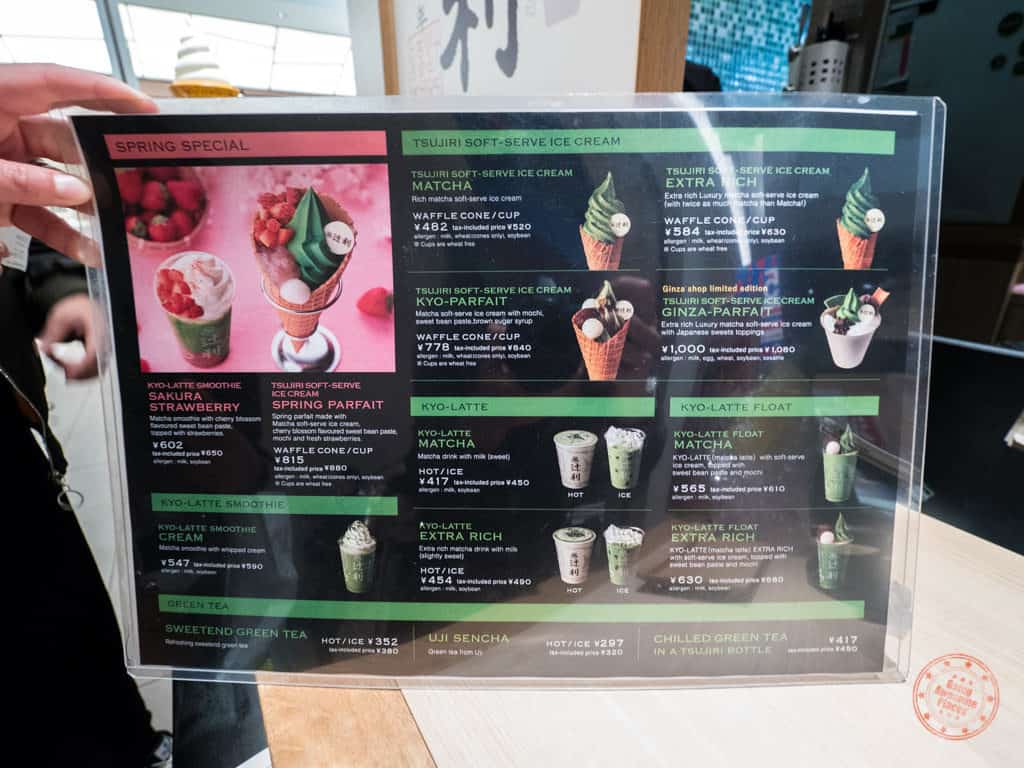
On the menu is an assortment of matcha soft-serve based items but we were definitely most interested in having it in it’s purest form. They offer two types of soft-serve – the cheaper regular Matcha and the more expensive Extra Rich which is described to have “twice as much matcha as Matcha”.
Of course we went with Extra Rich and boy were we impressed. The soft-serve is smooth and creamy while packing extra strong Uji matcha flavours that is strongly but satisfyingly bitter.
The price between cone and cup are the same so why not go for the cone?
Neighbourhood: Ginza
Open hours: 10:30AM – 8:30PM M-Su
Address: (See map)
Price: Extra rich matcha soft serve (584 JPY – $6 USD)
English menu?: Yes
4. Angels Heart
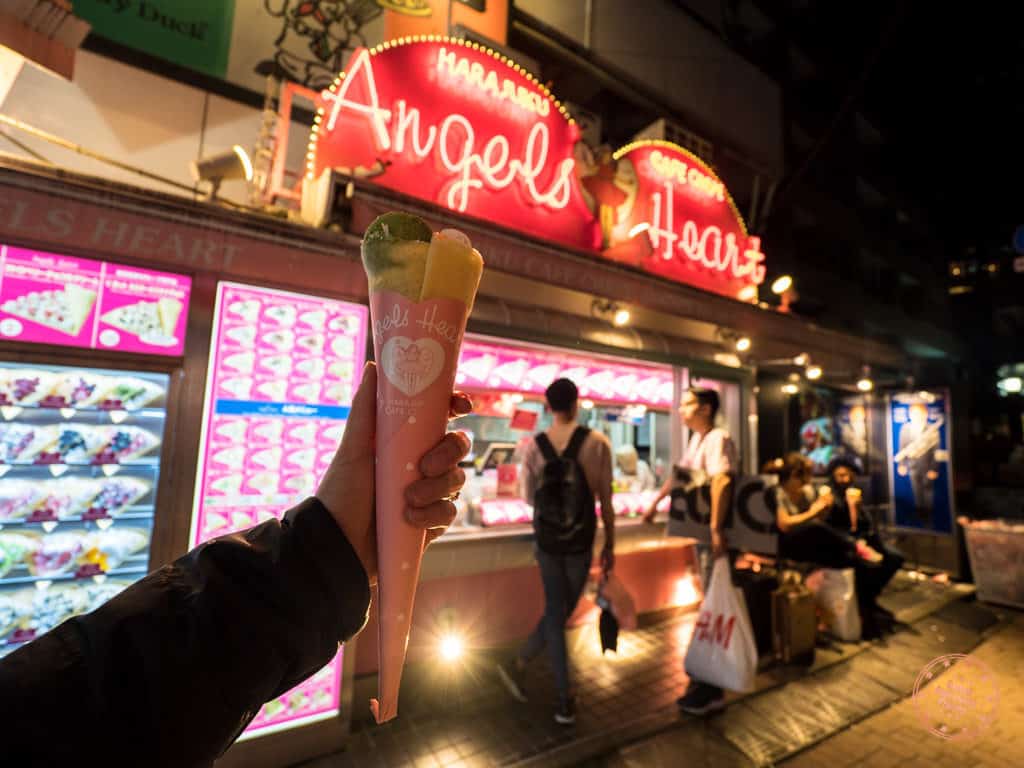
And you thought I was done with Harajuku! We discovered this on our first trip to Tokyo and it certainly wouldn’t be our last. Paired up with Zaku Zaku, we needed to make sure we had enough stomach room for one more dessert.
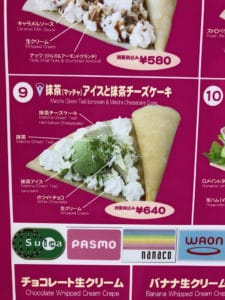
Long before croquant chou was even a thing, Harajuku was mainly known for their decadent crepes. It wasn’t enough just to just put Nutella and fruit on crepes as the French had done but they had to take it a step further and slam it with ice cream and cheesecake on top. It was so deliciously good that it’s a style of crepe in a cardboard cone holder that’s simply called the Harajuku Crepe.
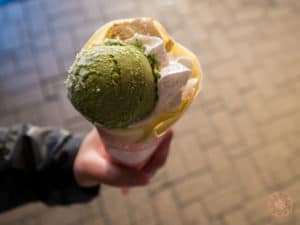
There are several stalls that serve this dessert but the one we always go back to Angel’s Heart which is in the middle of Takeshita Street. The walls are plastered with pictures of menu options and the one I highly recommend is the one with green tea ice cream and cheesecake.
Neighbourhood: Harajuku
Open hours: 10AM – 9:30PM M-Su
Address: (See map)
Price: Green tea ice cream and cheesecake crepe (640 JPY – $6 USD)
English menu?: Yes
5. Japanese Ice OUCA (食べログ)

Last but not least is this ice creamery located at a busy intersection in the neighbourhood of Ebisu. In this small cafe, you’ll have your choice of ice cream and gelato – some of which are standard and others which are special based on the season. Everything is homemade.
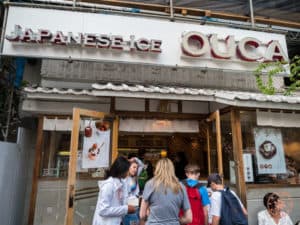
Overloaded with choices in flavour, colour, and special options, we ended up picking the skewers of mochi (called dango) glazed in a soy syrup with their evergreen matcha gelato on top. An unorthodox combination? Yes, absolutely. I think both of us regretted the choice after as we found the salty-sweet combination of the soy glaze and the bitterness of the matcha to clash. The dango also wasn’t freshly made as we watched them just grill up pre-made ones so it didn’t have the elastic bounce I was expecting.
While the clash was strong, I thought the matcha gelato was excellent. Not as rich as Tsujiri but with a texture that could easily fool you as ice cream, it held up its own as some of the best ice cream we had in Japan.
If I were to come back, I’d stick to the basic cup of 3 selection ice cream.
Wheat green tea is complimentary if you’re eating in their limited-space cafe. Also, if you order one of their ice cream cups, it comes with kombu flakes to cleanse your palette after the sugar overdose.
Neighbourhood: Ebisu
Open hours: 11AM – 11PM M-Su
Address: (See map)
Price: Dango with green tea gelato (400 JPY – $4 USD)
English menu?: Yes
Places We Missed
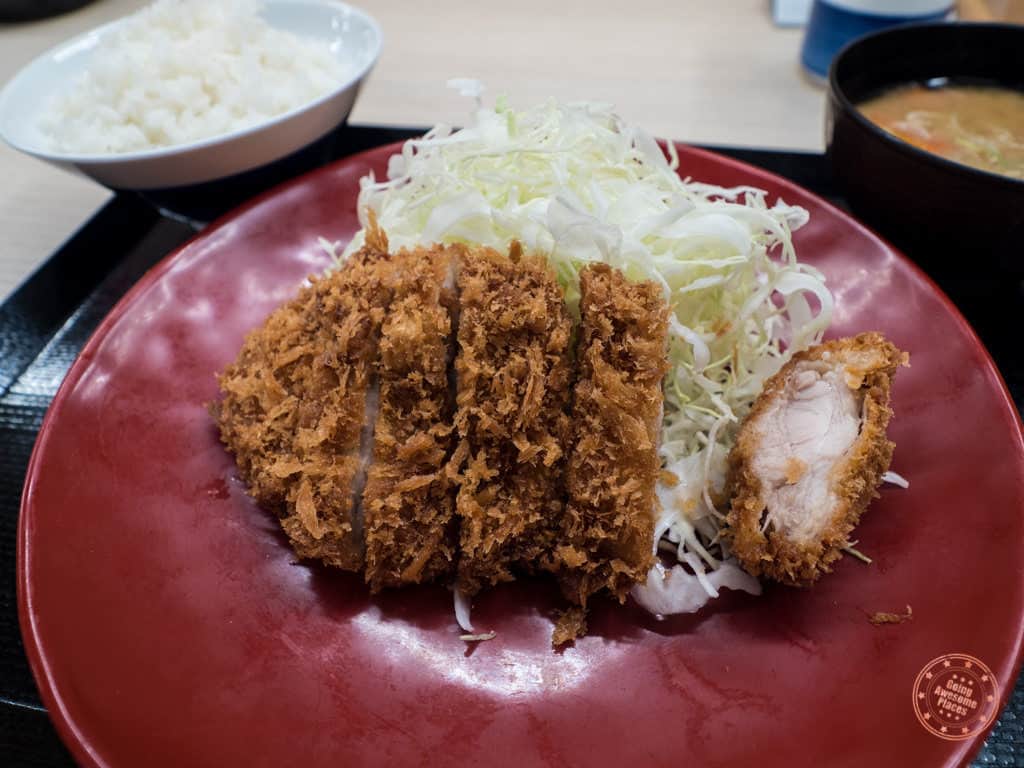
In 6 days I feel like we barely made a dent into everything Tokyo has to offer. As you plan out your foodie vacation, here are some of the other things you don’t want to miss out on.
Types of Food We Didn’t Get To
- Shabu shabu
- Takoyaki
- Japanese BBQ
- Steak (Waygu and Kobe beef)
- Omakase
- Soba
More Places I Didn’t Feature
There are more restaurants that I wasn’t able to feature on this list but I did add them to the Tokyo Food Map. These include restaurants that we tried or ones that were in the plans but just didn’t have time or the stomach room for.
How much does 5 days in Tokyo cost?
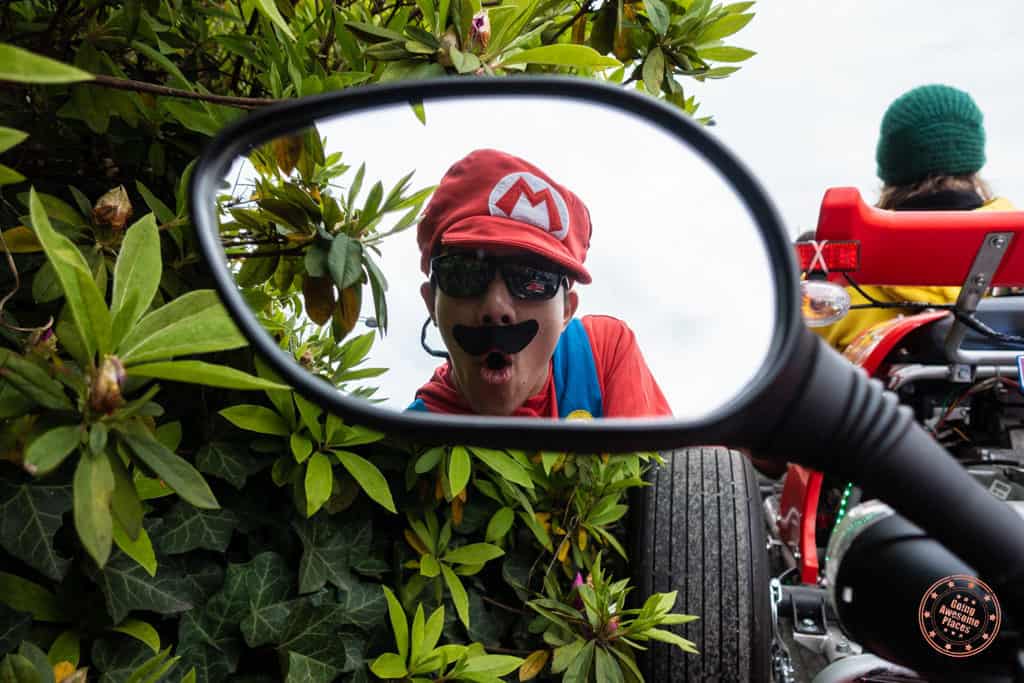
It’s no secret that Tokyo is one of the most expensive places in the world. I kept track of our expenses over the course of our 6 days in the city and here is a breakdown of how much we spent.
- Food: $437 USD
- Souvenirs: $294 USD
- Accommodation: $188 USD (6 nights at the Airbnb)
- Transportation: $99 USD (not including flights)
- Activities: $189 USD (mainly MariCAR)
- Currency: $4 USD (ATM fees)
TOTAL: $1,211 USD
This breaks down to $201 per day and furthermore $100 per day per person.
Food of course is where we spent the most money but from my list above, you’ll see we didn’t really splurge on any particular place which helped keep our cost low. We definitely ended up spending a bit more on souvenirs which can be broken down into our shopping at Daiso, Don Quijote, and the local supermarkets.
We saved a ton by going cheap on accommodations but that can easily balloon to $1,000 in Tokyo if you’re staying in the city.
Wrap Up
There’s an endless amount of things to see, do, and eat in Tokyo. Our 6 days there was a blitz of food that resulted in intense exercise of our stomachs and our feet.
One thing is for sure, it did not disappointed. The most impressive thing is just how much care they put into every piece of food that is placed on the dish. Everything is there for a reason and it’s the combination of all the freshest ingredients and method of preparation that results in incredible dining experiences whether they’re on the street or in a fancy restaurant.
So what are you waiting for?
Looking for activity ideas in Tokyo?
Akihabara Anime & Gaming Adventure Tour – Akihabara is an awesome neighbourhood to explore that isn’t covered in this particular guide as somewhere with a specific restaurant to visit but if you’re a fan of anime, manga, maids, video games, and toys. This tour gives you a 3 hour interactive experience including going to a maid cafe, trying out a Japanese photo booth, and being shown the best spots for anime.
Read these next!
- Souvenirs you have to buy before you leave Japan
- Where to stay in Tokyo
- Best ramen in Tokyo
- Must have food in Osaka
- Tips for getting around Tokyo by train
- Best ryokans in Kyoto
Thinking about a JR Pass?
If you’re looking to do any travelling around Japan, I highly recommend picking up a JRailPass. Keep in mind that you’ll need to purchase it before your trip and ship it to your home.

